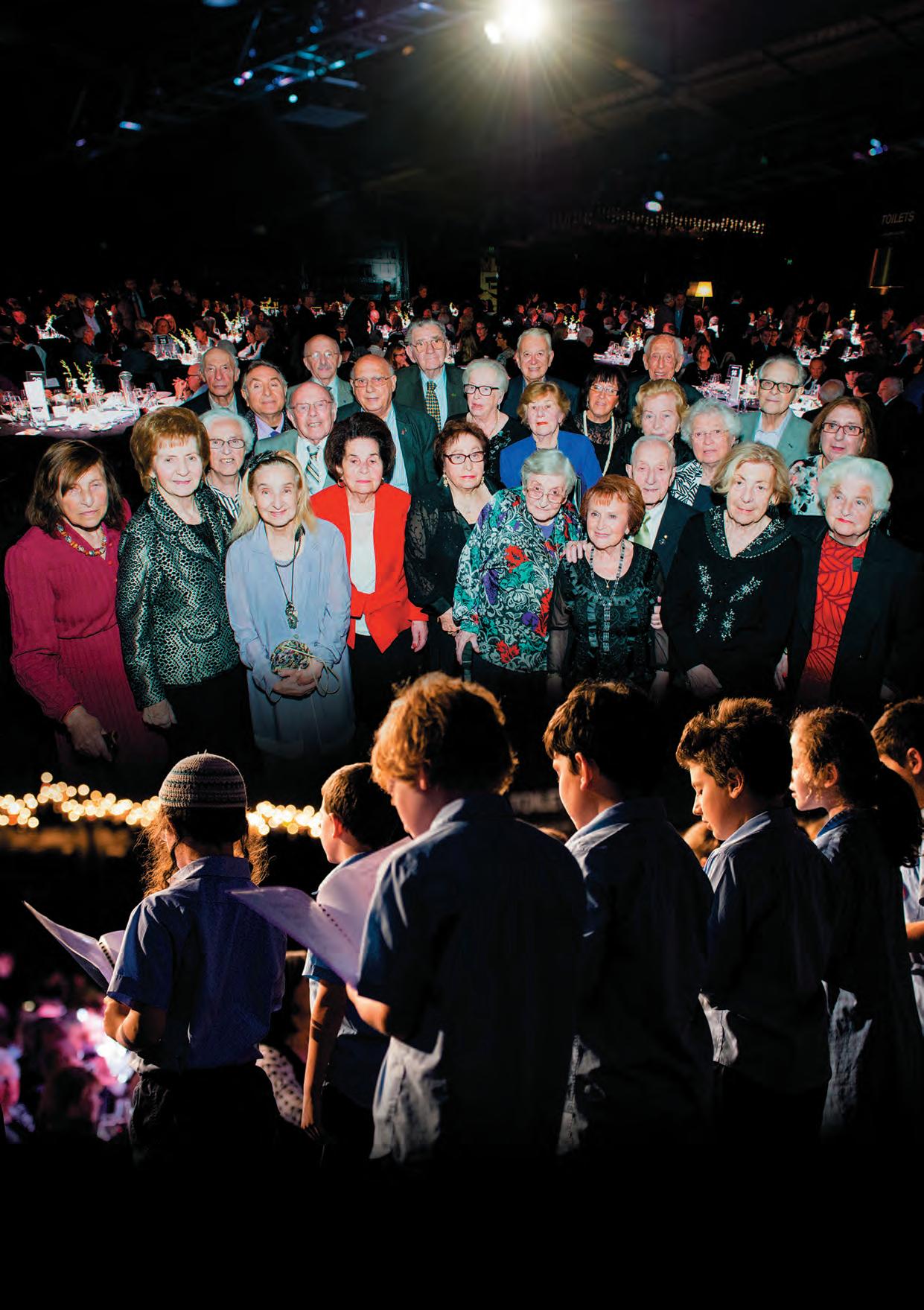
September 2014 Jewish Holocaust Centre Registered by Australia Post. Publication No. VBH 7236 The magazine of the Jewish Holocaust Centre, Melbourne, Australia Remember the Past Change the Future 1984-2014 YEARS
JHC Board:
President: Pauline Rockman OAM
Immediate Past President:
Shmuel Rosenkranz
Secretary: Elly Brooks
Treasurer: David Cohen
Members: Goldie Birch, Allen Brostek, Alex Dafner, Cedric Geffen, Abram Goldberg OAM, Sue Hampel OAM, Paul Kegen, Helen Mahemoff, Viv Parry, Willy Lermer

JHC Foundation:
Chairperson: Helen Mahemoff
Trustees:
Nina Bassat AM
Joey Borensztajn
Allen Brostek
David Cohen
Jeffrey Mahemoff AO
Patrons:
Professor Yehuda Bauer
Mrs Eva Besen AO
Mr Marc Besen AO
Sir William Deane AC CBE
Sir Gustav Nossal AC CBE
Mrs Diane Shteinman AM
Steven Spielberg
JHC Staff:
Warren Fineberg, Executive Director
Lisa Phillips, Director of Education
Jayne Josem, Curator, Head of Collections
Michael Cohen, Community Relations Coordinator
Reuben Zylberszpic, Development Manager
Phillip Maisel OAM, Head of Testimonies
Project
Robbie Simons, Testimonies Assistant
Coordinator / Audio-visual Producer
Tammy Reznik, Education Officer
Anatie Livnat, Education Officer
Rae Silverstein, Volunteer Coordinator
Claude Fromm, Assistant Archivist
Daniel Feldman, Project Administrator
Julia Reichstein, Librarian / Information Manager
Lena Fiszman, Office and IT Manager
Tosca Birnbaum, Reception
Centre News
The Jewish Holocaust Centre is dedicated to the memory of the six million Jews murdered by the Nazis and their collaborators between 1933 and 1945.
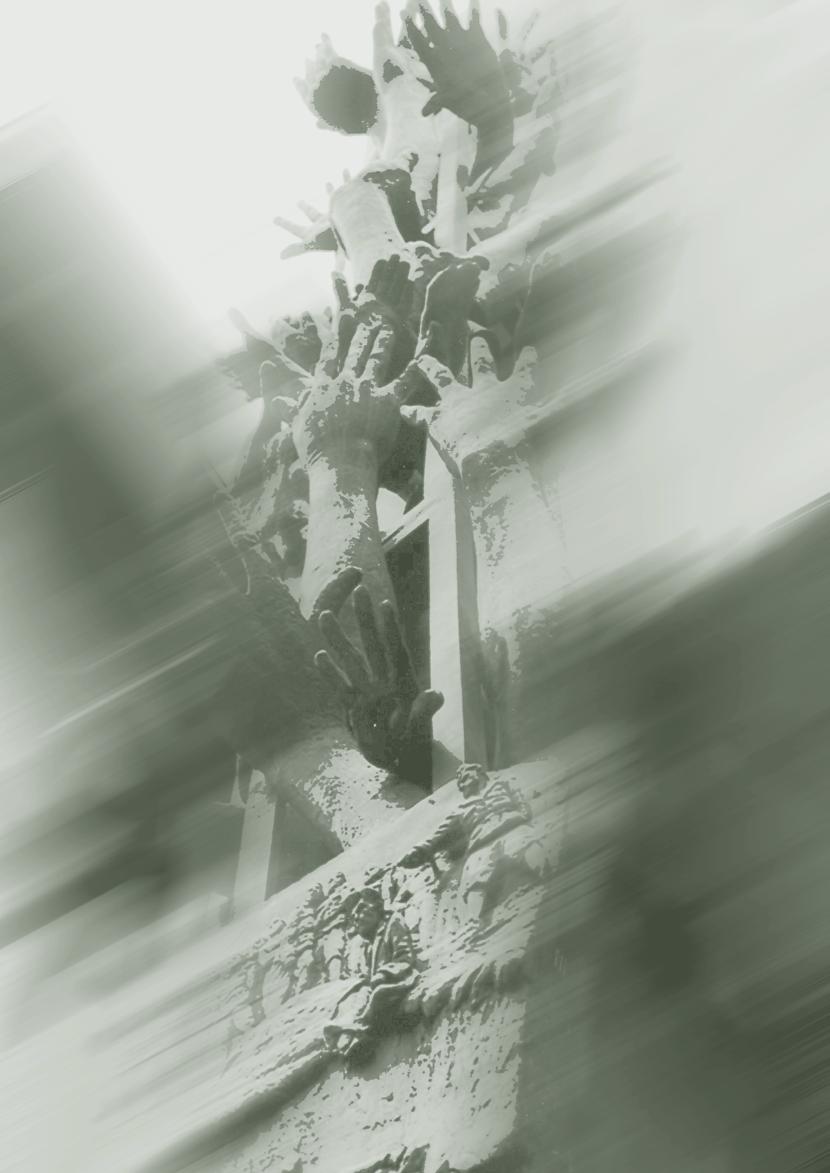
We consider the finest memorial to all victims of racist policies to be an educational program which aims to combat antisemitism, racism and prejudice in the community and fosters understanding between people.
CONTENTS
On the cover:
Holocaust survivors and the Sholem Aleichem College choir at the Jewish Holocaust Centre gala dinner, May 2014.
Photos: Simon Shiff
This publication has been designed and produced by Izigraphics Pty Ltd www.izigraphics.com.au
13–15 Selwyn Street
Elsternwick Vic 3185 Australia
t: (03) 9528 1985
f: (03) 9528 3758
e: admin@jhc.org.au
w: www.jhc.org.au
OPENING HOURS
Mon–Thu: 10am–4pm
Fri: 10am–2pm
Sun & Public Hols: 12pm–4pm
Closed on Saturdays, Jewish Holy Days and some Public Holidays
Disclaimer: The opinions expressed in Centre News are those of the authors and do not necessarily reflect those of the magazine editor or editorial committee. While Centre News welcomes ideas, articles, photos, poetry and letters, it reserves the right to accept or reject material. There is no automatic acceptance of submissions.
JHC Centre News
Editorial Commitee: Editor: Ruth Mushin Michael Cohen Lena Fiszman Jayne Josem Pauline Rockman OAM Reuben Zylberszpic Moshe Ajzenbud (Yiddish) From the President 3 Editor’s letter 3 Director’s cut 4 Education 5 The Jewish Holocaust Centre celebrates its 30th anniversary at a gala dinner 6 Remembering the Jewish Holocaust Centre’s 30 years: a personal reflection 8 A Future for the Past: reflections on a conference 10 From a Year 11 field trip to researching gender and sexual violence in Holocaust film 12 What don’t we know? Unanswered questions from the Holocaust 14 Child Survivors of the Holocaust Melbourne s eal a time capsule to be opened in 2064 16 Leon Jedwab: a survivor from Zagorow 17 An autumn journey 18 The Jewish Holocaust Centre hosts a Welcome to Country and Smoking Ceremony 19 Australian reflections: one year of Holocaust Memorial Service 20 Book review: Totally Unofficial: The Autobiography of Raphael Lemkin 21 Lodz Ghetto: the Strength of Hope: an online Lodz Ghetto exhibition in memory of Bono Wiener 21 Fearless leadership is critical for a good society: reflections on March of the Living 22 Some highlights of my March of the Living experience 23 JHC Social Club 24 Friends of the Jewish Holocaust Centre 25 Seen around the Centre 26 Stories from the Collection 28 What makes the Holocaust different? 29 William Cooper remembered through the Jewish Holocaust Centre, Wilson Family Scholarship 30 Community news 31
Pauline Rockman OAM
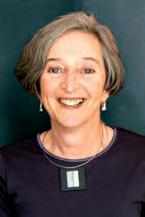
On 20 May I was privileged to be involved in the Jewish Holocaust Centre’s 30th anniversary gala dinner held at Peninsula at Docklands. And what a night it was!
Six hundred guests – Holocaust survivors, Jewish Holocaust Centre (JHC) supporters and their guests –gathered in this amazing space. My thanks to the wonderful team of JHC staff and volunteers, and particularly to Helen Mahemoff, who worked so hard to organise this event.
To open the night, our MC, Michael Cohen, asked our beloved Holocaust survivors to stand. The applause was tumultuous, setting the tone for the rest of the evening. The Sholem Aleichem College choir sang in Yiddish and our guest speaker, Major General (Ret) Ido Nehushtan, spoke movingly. His words, ‘We weren’t there then, but we are now’ resonated deeply with our survivors and the second and third generations. As I shared the podium with survivor Halina Zylberman and JHC Treasurer and third generation David Cohen, the atmosphere was almost palpable.
EDITOR’S LETTER Ruth
Over 30 years ago, a group of Melbourne Holocaust survivors, with little external financial support, had the courage, foresight and determination to create a museum, an educational institution and a commemorative place. Five years ago, at the Centre’s 25th anniversary, I pledged that my generation would uphold the legacy of our founders, and I believe we are doing just that. I am very proud of the achievements of my Board, our survivors, staff and volunteers, and the JHC Foundation. I do not believe the founding Holocaust survivors would have imagined that what they had built would grow into the vibrant organisation we have today, with over 20,000 secondary students and 10,000 visitors from the general public walking through our doors annually.
Today we are still blessed to have survivors active at the Centre. In the words of my dear friend and mentor Kitia Altman, ‘For me, the Holocaust Centre always was, and remains, a natural custodian of survivors’ memories and pain… forever.’
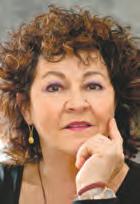
Some of our survivors who joined in the years after the Holocaust Centre was established are sadly no longer with us, but their voices are heard today and will continue to be heard into the future, on the video screens in the museum and through their testimonies.
In April I returned once again to Europe, co-leading a communal
leaders’ March of the Living (MOTL) group from Melbourne and Sydney. Once again, this was a most powerful journey for all. For the first time, MOTL commenced the journey in Berlin, Germany, the actual birthplace of Nazism. Our program began at the Australian embassy located in Mitte, in former East Berlin, on the eve of Anzac Day. Together with David Ritchie, Australian Ambassador to Germany, we walked across the road to a deserted building, where a building owned by my grandparents – and destroyed during the Second World War – once stood. There I gave a testimony in memory of my family. After three intensive days in Berlin we flew to Cracow, Poland. On Yom HaShoah we marched together from Auschwitz I to Birkenau with young Jewish students from all over the world, as well as many non-Jewish participants.
This year marked 70 years since the destruction of the Hungarian Jewish community. The words of Cecilia Ahlberg, great-niece of Raoul Wallenberg, who took part in the MOTL Yom HaShoah ceremony at Auschwitz II-Birkenau, left us with a profound message: ‘We cannot all do everything, but we can all do something, because you make a difference. Every person can make a difference.’
Wishing you all l’shana tova
How many of you have noticed the very small print beneath the Jewish Holocaust Centre’s 30 th anniversary logo ‘Remember the Past Change the Future’? During this anniversary year, Centre News continues to feature the special events that have focused on that message. Saba Feniger’s personal
reflection, which appears in this edition, provides a history of the Centre from someone who has been actively involved in the JHC, almost from the first day. We also feature the Gala Dinner, held in May, which was a celebration of the past 30 years, as well as a glimpse at the plans for the Centre’s development into the future.
In July, the Centre, together with Deakin University, hosted a major international conference entitled The Future of the Past: Representing the Holocaust, Genocide, and Mass Trauma in the 21st Century. As this year also marks the 20 th anniversary of the Rwandan genocide, the conference was fittingly launched by Michael Roux, the Honorary Consul General of Rwanda in Australia, and
included a panel discussion of the ongoing effects of the genocide.
Articles by presenters Matt Lawson and Deb Waterhouse-Watson will give you an idea of the great breadth and depth of the conference program. Despite the extensive and valuable research that has been undertaken about the Holocaust, Dr David Silberklang, Senior Historian at Yad Vashem, has written a thoughtprovoking article about what we don’t know, identifying Jewish communities affected by the Holocaust that have not yet been studied, unanswered questions and areas for further study.
This is just a small taste of the next forty pages. I hope you enjoy reading them.
JHC Centre News 3
FROM THE PRESIDENT
Mushin
Warren Fineberg
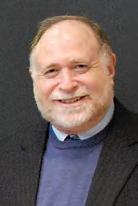
Centre News is the Jewish Holocaust Centre’s flagship publication for informing the community about what we do and what we believe is important in the area of Holocaust remembrance, education and research. Our collection of past copies has been a valuable resource in chronicling the work of the Centre over the last 30 years. I am grateful to our editor, Ruth Mushin, who manages to keep contributors to schedule and who produces a magazine of such fine quality.
The gala dinner held in May to mark the 30 th anniversary of the JHC’s establishment and coordinated by a dedicated team of volunteers and staff (Helen Mahemoff, Elly Brooks, Goldie Birch, Pauline Rockman OAM and Reuben Zylberszpic) was an outstanding success. It brought together supporters to acknowledge our progress and to contemplate plans for the future. Special materials produced for the gala include the commemorative booklet, edited by Ruth Mushin, with photography by Zina Sofer and graphic design by Izi Marmur, and the wonderful video produced by Robbie Simons. I wish to acknowledge and to thank our 30th Anniversary supporters – the Gandel Family and Gandel Philanthropy; Les and Kathy Janovic (in memory of Dezso and Medi Janovic); and Gala supporters Sunraysia Foundation; Jeffrey Mahemoff AO and Helen Mahemoff; Pauline Rockman OAM and Sandra Jedwab; Regine Szmulewicz (in memory of Rushka and Ksiel Szmulewicz); Gary Peer; Lowe Lippmann; Highpoint Property Group; Bank of Melbourne; Outdoor Fitness Hub; and Arnold Bloch Liebler. I would also like to thank those who attended and donated generously to the Centre and the Jewish Holocaust Centre Foundation.
Yom HaShoah had particular significance to us this year as we remembered the plight of Hungarian Jews and the liquidation of the remaining ghettos 70 years ago. Survivors and members of the second generation commenced the commemoration with candle lighting at the Jewish Holocaust Centre, where El Maleh Rachamim was intoned by Michael Cohen and Kaddish recited by all present, prior to the JCCV-sponsored commemoration held at Monash University’s Robert Blackwood Hall.
In June the Centre joined with members of the Kulin nation and other Aboriginal people to hold a Welcome to Country and Smoking Ceremony on the Wurundjeri Willam land at the entrance to the Centre. In attendance were Boon Wurrung Foundation CEO, Senior Elder Carolyn Briggs; Senior Boon Wurrung Foundation Representative, Aboriginal Elder Dean Stewart; Auntie Jacko; Dr Teresa de Favio of the Victorian Multicultural Commission; and John Searle, Chairman of the Victorian Equal Opportunity and Human Rights Commission.
Viv Parry, who has worked with indigenous communities for some time, liaised with the elders on behalf of the Centre to bring this significant event to fruition.
There are strong parallels between the Aboriginal and Jewish people – their long history, connection to the land, and strong sense of belonging, culture and respect. Since its establishment the Jewish Holocaust Centre has enjoyed a close relationship with the Aboriginal community. Aboriginal activist Willliam Cooper’s 1938 protest in Melbourne against the actions of the Nazis during the Kristallnacht pogroms has further cemented the relationship between the JHC and Aboriginal people. Today we enjoy regular visits from Galiamble Men’s Recovery Centre and indigenous students from schools across the state. The Welcome to Country and Smoking Ceremony represents another milestone in the developing relations between the Jewish Holocaust Centre, Holocaust survivors and others who work at the Centre, and the Aboriginal people.
The Centre regularly undertakes research on a range of topics.
Curator Jayne Josem has recently completed two years of work collecting artefacts and stories about the Lodz Ghetto. A valuable on-line exhibition, sponsored by the Bono Wiener Estate, can be found on the JHC website under the heading ‘Museum & Collections’. We encourage you to visit the site.
Another research project has focused on the Thassaloniki Jewish community during the Holocaust years, and I would be grateful for any information readers may have that could assist with this project. The Centre has applied to Yad Vashem for Constance Koster to be recognised as a Righteous Among the Nations for her selfless assistance rendered to Dutch Jews during the Holocaust, and we await the outcome. The Education team headed by Lisa Phillips, together with the Coordinator of Volunteers Rae Silverstein, are finalising plans for the Custodians of Memory project. Two programs are being investigated, one supporting guides to become custodians of memory for the survivors with whom they work at the Centre, and the other for people of all ages to become custodians of memory and to have opportunities to pass on the stories and messages of our survivors in years to come.
Each year the JHC Foundation provides support for the Centre’s activities. Part of this funding has been earmarked for a ‘smart TV’ for the Board Room. This will be used for meetings and presentations, to facilitate communication with other museums and groups internationally, and to present video archives to students during small group work.
There are many more projects and events to capture your interest, some of which are reflected in the articles and reports in the pages that follow.
JHC Centre News 4
DIRECTOR’S CUT
EDUCATION
Since my appointment as director of education at the Jewish Holocaust Centre (JHC) earlier this year, I have been impressed by the cross-section of Victorian schools that visit the JHC, reflecting the multicultural reality of Australian society. In an age where taking students out on excursions is increasingly difficult, teachers go to enormous trouble to bring their students to the Centre to learn about the importance of standing up to prejudice and hatred.
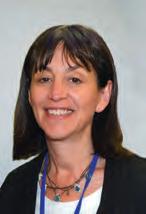
As the Museum of Tolerance in Los Angeles highlights, we all hold prejudices. Last April, by joining the Community Leaders’ March of the Living (MOTL) group, I held up a mirror to scrutinise my own prejudices. Unlike my children and their friends who have visited Poland and the extermination camps as part of a one-year program in Israel, and like many of my generation, Germany and Poland have not been destinations of choice to visit. While I teach about the perils of racism, my own worldview has been coloured by prejudice as a result of stories of those who betrayed friends’ families in the Holocaust, and the fear of antisemitism as recorded in accounts of events like the 1946 Kielce Pogrom. I chose to learn French rather than German at school, and I have generally chosen not to buy German products. When we first met as a MOTL group prior to our trip, it was suggested to keep an open mind. My worldview was about to be challenged.
For the first time since MOTL’s inception, our group spent three days in Berlin before travelling to Poland. There we learnt about the development and planning of the Final Solution, but also how a nation is coming to terms with being perpetrators of such horror. The themes of memorialisation were strongly woven throughout our visit, as was the theme of the ‘absence of the presence’, so strongly demonstrated by the Stolpersteine (stumbling blocks). These brass plates imbedded in the pavements across Europe are a way to remember individual victims of the Holocaust and link them to a physical place. It was, however, our visit to Grunewald station, one of three main deportation sites in Berlin, which resonated the most strongly with me. Standing on Platform 17, the beginning of the journey, one views a series of metal plates that record each train deportation with the date, destination and the number of Jews on each transport. The birch trees swaying with their iridescent green spring leaves were incongruous with the horror of this site where the trains, directly in the middle of a wealthy suburb, left for Auschwitz and other concentration camps. This place was simultaneously memorialising the dark past and intersecting with the present, as Grunewald still functions as an urban station.
This first day set in motion the emotional roller-coaster of my MOTL experience – a closer insight into the Holocaust, combined with an increasing appreciation of how Germany or Poland remembers its past. In Germany my own prejudices were challenged as I began to recognise how well this nation is coming to terms with its past. In Poland, I began to acknowledge that the Poles were very much victims of the Nazis’ execution of their policies. This is something I knew, as I have always taught about other victims in the Second World War, but it is not something I had felt.
When I reflect about it now, perhaps it was walking through Majdanek, a place of pure evil and brutality, with our wonderful guide Krzysztof Banach, Director of Curation, that was a key turning point for me. His explanations and insights combined with his own connection to Majdanek – his grandfather was imprisoned as part of Nazi collective punishment –helped me begin to re-examine my views. Both Krzysztof Banach and Ewa Koper, Museum Director at Belzec, impressed me because they are both so dedicated to their work in examining, acknowledging and educating about the darkness of the Shoah. Other things, including visiting the new Museum of Jewish History in Poland in Warsaw, and the kindness of a young Polish girl who came to our aid on the train to Lublin, also helped to break down my prejudices. Most importantly, it was Pauline Rockman and Sue Hampel who offered our group new ways to reflect upon the Shoah and who helped me to revisit my longheld views.
Back at the JHC, at the end of the survivor testimony during a school visit, one student will invariably ask our survivor, ‘Do you hate Germans?’ The answer will only vary slightly. The survivor will look the student in the eye and say ‘No.’ Some will go on to explain, ‘I cannot forgive or forget, but I do not hate.’ Or, ‘You can’t hate a whole nation, you can’t hate the new generation; they are not guilty. You can’t live with hatred otherwise you will destroy yourself.’ These responses are often the most powerful moments in our program, during which the survivor is able to transmit successfully the message of the futility of hatred to the students. The students are challenged to reflect upon their own views and prejudices, and leave the JHC with a new paradigm to view the world. The survivor message is an important one, as we all need to be challenged constantly about the prejudices we hold.

JHC Centre News 5
Lisa Phillips
The Jewish Holocaust Centre celebrates its 30th anniversary at a gala dinner
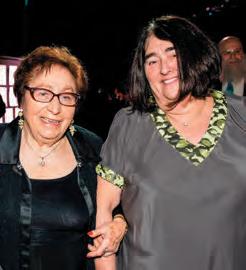
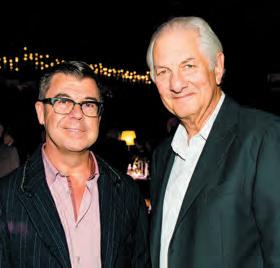
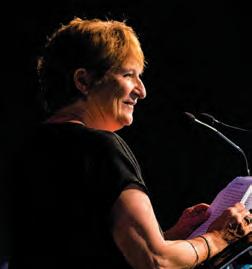
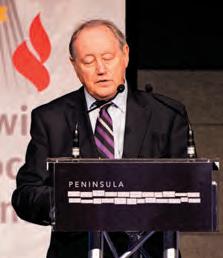
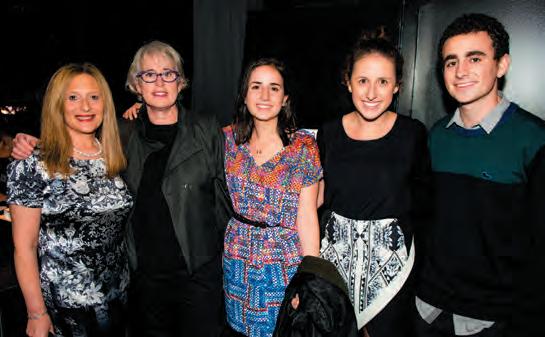
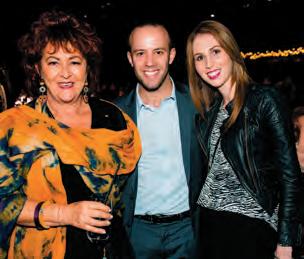
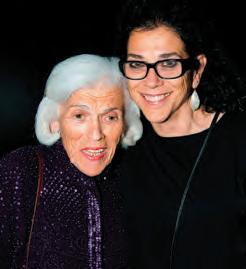
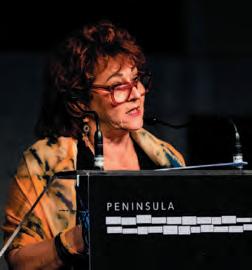

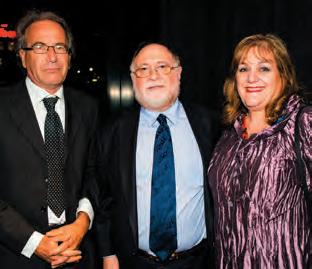
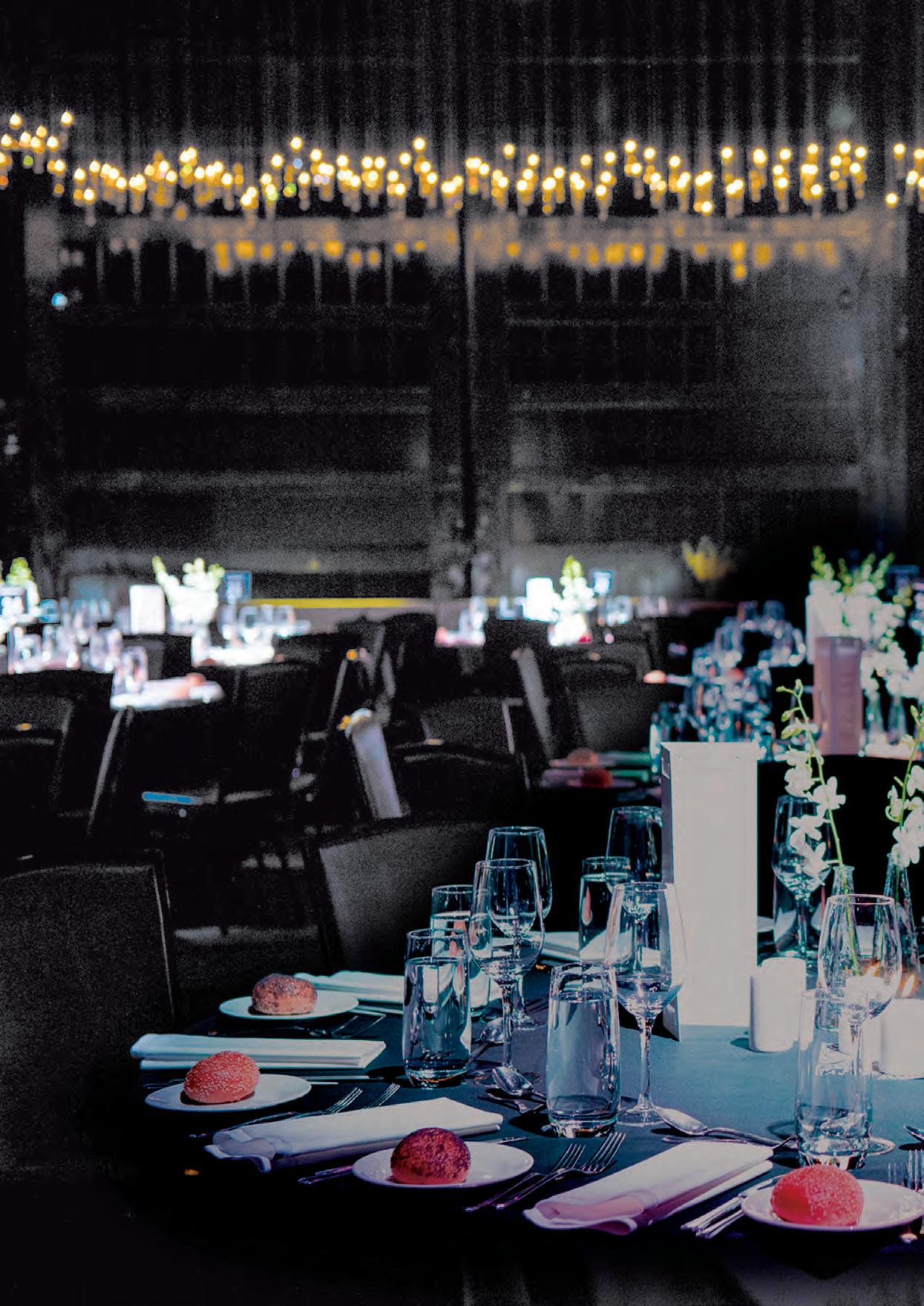
The Jewish Holocaust Centre (JHC) marked its 30th anniversary with a gala dinner in May, held at Peninsula at Docklands and attended by 600 people. The organising committee for the dinner comprised Helen Mahemoff, Pauline Rockman, Goldie Birch and Elly Brooks. The committee was assisted by JHC staff members Warren Fineberg, Reuben Zylberszpic, Tosca Birnbaum and Lena Fiszman, and members of the Friends of the JHC committee. An overwhelming response resulted in a lastminute change of venue.
The evening commenced with the formal recognition of the Holocaust survivors who have been the lifeblood of the Centre, working tirelessly as museum guides and volunteers in every department of the Centre since its establishment. The Sholem Aleichem College choir then sang two Yiddish songs in honour of the survivors. This commencement of proceedings created a wonderful atmosphere which set the scene for the rest of the evening. Further entertainment was provided by Lior, one of Australia’s preeminent singer-songwriters and a seven-time ARIA nominee.
Major-General Ido Nechushtan (Ret), who served for five years as Commander of Israel’s Air Force, was guest speaker.
(l-r) Benny Rosenzweig, Warren Fineberg and Alice Peer
(l-r) front Helen Greenberg, Cesia Goldberg and Abram Goldberg OAM, back Paul Greenberg, Natassia Bornsztejn, Daniel Goldberg, Elisabet Goldberg and Charlie Goldberg
Pauline Rockman OAM (l-r) Sarah Szental and Lilly Harris
(l-r) Pauline Rockman OAM, Paul Kegen and Jenna Kegen (l-r) Goldie Birch, Elana Lewin, Sassy Lewin, Jade Lewin and Aron Lewin
Michael Cohen
Helen Mahemoff
(l-r) Richard Rogers and Barry Bloom (l-r) Freda Schweitzer and Tosca Birnbaum
Photography: Simon Shiff
In his capacity as head of the air division of Israel’s air force, Nechushtan led a delegation of 180 IDF officers to the Auschwitz-Birkenau death camp on 4 September 2003 to participate in a special commemoration ceremony. He was responsible for coordinating three Israel Air Force F15 fighter jets to fly over the death camp as a memorial salute during the commemoration. After a video of the flyover was screened, Nechushtan, who was introduced by JHC Foundation chair, Helen Mahemoff, recounted the events which led to the flyover, explaining that the date, 4 September, coincided with a particular transport to Auschwitz of French Jews from the Drancy deportation centre.
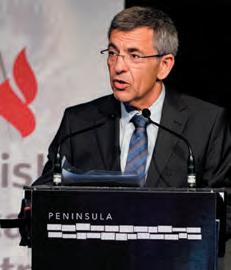

Holocaust Centre president, Pauline Rockman, briefly traced the history of the Centre, established 30 years ago by a group of Melbourne Holocaust survivors with little external financial support, who, she said, had the courage, foresight and determination to create a museum, an educational institution and a commemorative place in an old dance hall located in Selwyn Street, Elsternwick, sourcing the materials themselves. ‘They were all volunteers, untrained in setting up a museum yet spurred on by their passion and determination. As the Centre grew, we expanded the premises and now occupy two adjacent buildings.’
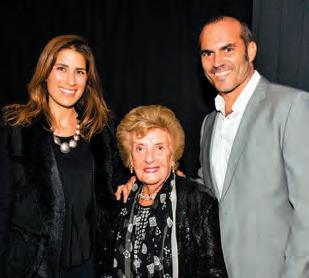
Polish-born Halina Zylberman, Holocaust survivor guide at the JHC, spoke about the importance of her voluntary work at the Centre over 25 years. ‘It is very important that the messages we teach – the importance of respect, tolerance and human dignity – are heard by the thousands of students who come to the Centre and that these messages are passed on to the next generation,’ she said.
JHC treasurer David (Doov) Cohen, who serves on the Centre executive and as treasurer of the Centre’s board, spoke as a member of the third generation. He referred to plans to expand the JHC’s facilities in order to accommodate the Centre’s phenomenal growth. This includes the increasing number of schools visiting the Centre: over 20,000 students from at least 750 schools visit the Centre for programs annually.

The evening concluded with a fundraising appeal launched by Pauline Rockman to ensure that the legacy bequeathed by the founders of the Centre is preserved in perpetuity.
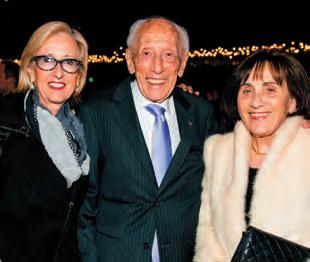

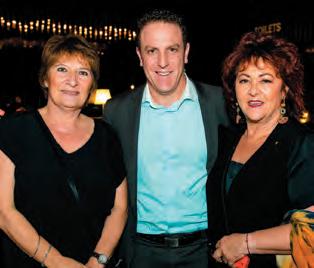

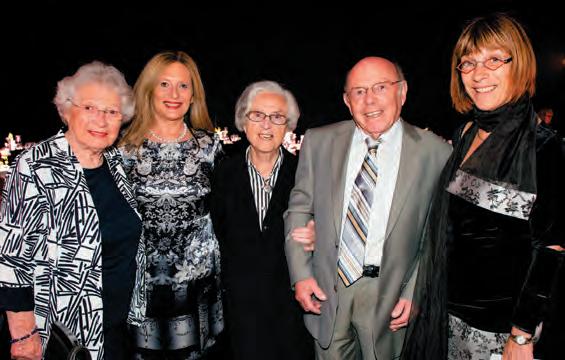

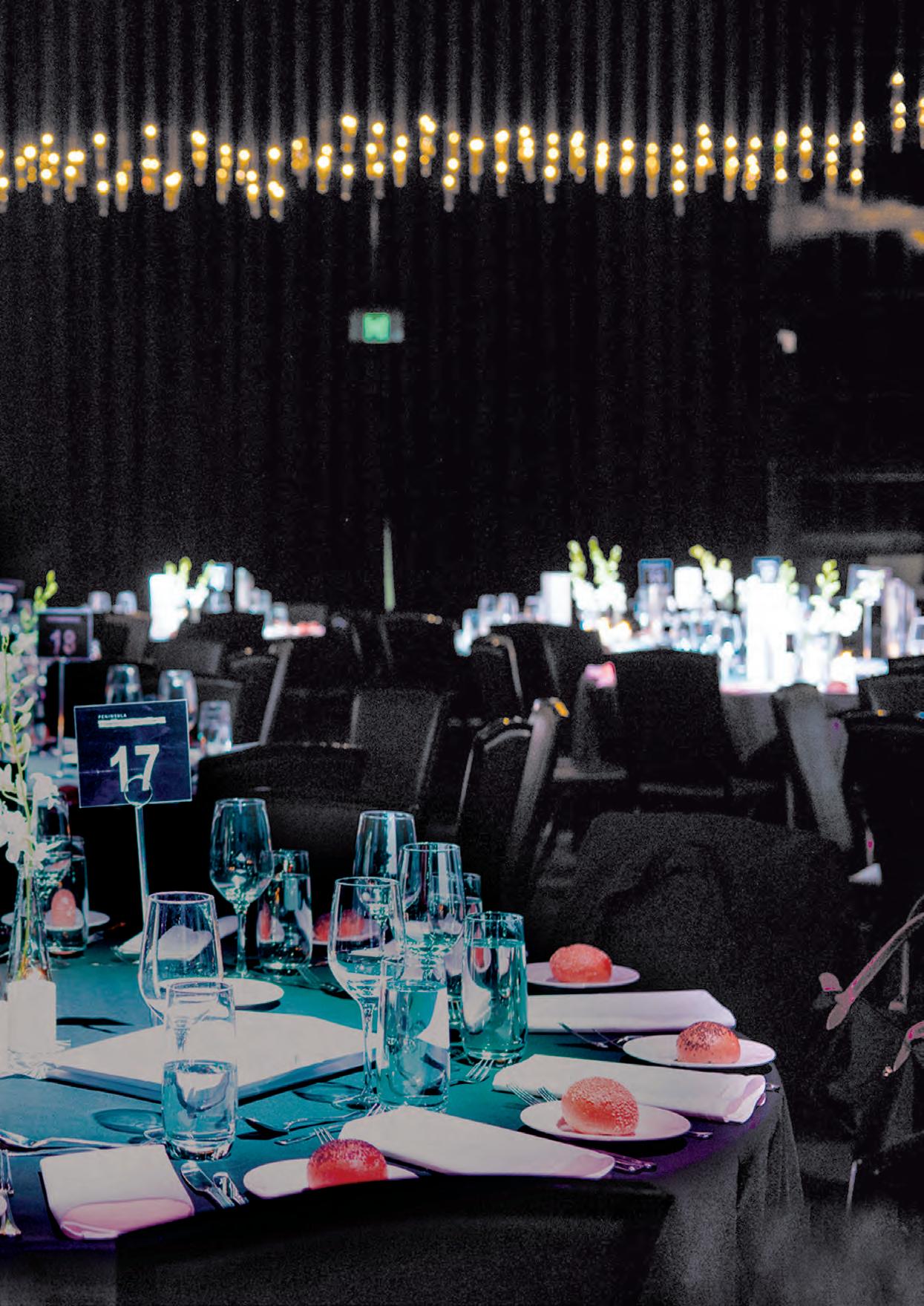 (l-r) Robert Hanner, Irma Hanner and Mary Mass Hanner
(l-r) Saba Feniger, Goldie Birch, Rosa Freilich, Phillip Maisel OAM and Elly Brooks
(l-r) Tammy Reznik and Robbie Simons
Halina Zylberman
(l-r) Ronit Hoppe, Pola Hoppe and Josh Hoppe
Lior
(l-r) Helen Mahemoff, David (Doov) Cohen, Pauline Rockman OAM
(l-r) Karen Goldman, Michelle Rothman, Leon Rothman, Niki Saltzman, Mark Saltzman and Goldie Birch
(l-r) Judy Seigel, Max Stern and Magda Levy
Major-General Ido Nechushtan (Ret)
(l-r) Robert Hanner, Irma Hanner and Mary Mass Hanner
(l-r) Saba Feniger, Goldie Birch, Rosa Freilich, Phillip Maisel OAM and Elly Brooks
(l-r) Tammy Reznik and Robbie Simons
Halina Zylberman
(l-r) Ronit Hoppe, Pola Hoppe and Josh Hoppe
Lior
(l-r) Helen Mahemoff, David (Doov) Cohen, Pauline Rockman OAM
(l-r) Karen Goldman, Michelle Rothman, Leon Rothman, Niki Saltzman, Mark Saltzman and Goldie Birch
(l-r) Judy Seigel, Max Stern and Magda Levy
Major-General Ido Nechushtan (Ret)
Remembering the Jewish Holocaust
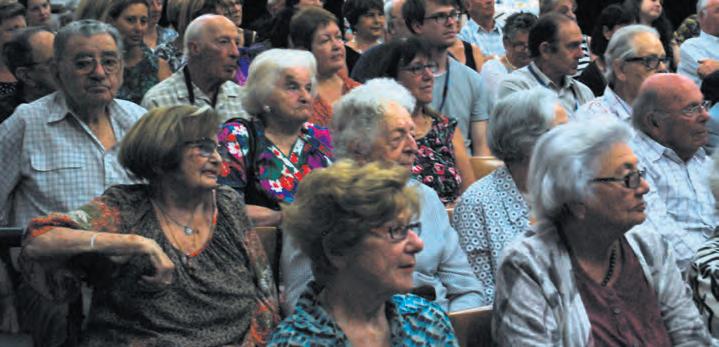
Saba Feniger
On 4 March 1984 the Jewish Holocaust Centre was officially opened in the presence of Yigal Lavi, the Israeli Chargé d’Affaires, and many local dignitaries.
The founders of the Centre were Aron Sokolowicz, President of the Polish Federation, Bono Wiener from the Kadimah, and later, Mina Fink. Both organisations – the Polish Federation and Kadimah – joined forces to establish an institution dedicated to the memory of Europe’s murdered Jews. With a substantial donation from Mina Fink, they were able to purchase the building next door to the Kadimah at 15 Selwyn Street Elsternwick. Further funds were subsequently raised and many people volunteered their services to turn the old building into what became the Jewish Holocaust Centre.
The first Executive Committee of the Centre included copresidents Sokolowicz and Wiener, co-vice presidents Yasha Sher and Abram Perlberg, secretaries Moshe Ajzenbud and Misha Eckhaus, treasurers Hersch Bachrach and Motel Roth, and later Abram Goldberg. Among the early volunteers were Sonia Wajcman, Rachel Baker, Adek Bialek, Heinoch Bienstock, Bronia Eckhaus, Leon Freilich , Ben Furmanski, Raya and Mark Langsam and Leon Mendelewicz.
The Jewish Holocaust Centre, a two-storey building, was formerly a dance hall. The downstairs area consisted of a hall and a couple of smaller rooms, which became offices. Mrs Eva Rattner was the secretary, the first and only paid member. She was followed by Betty Solomon and later Beryl Chitiz.
One of the early improvements to the Centre was the installation of Adela Shaw’s stained glass windows. The hall served many purposes, including an open library. The upper floor became a museum. The designer had installed aluminium panels, and enlarged photographs with English and Yiddish captions were placed into plastic covers and glued to the panels. Important information, written by historian Paul Bartrop, was also displayed separately. Although it was a primitive exhibition, it nonetheless had become a visual record of the horrors of the Holocaust not only for the public at large but also to enable the survivors to verify their mistreatment. The guides, all survivors, were volunteers, as were all the committee members.
I joined the guides in September. I might have spoken twice to students, but when I saw Lusia Lenk and Mietek Muchnicki working upstairs to improve the look of the exhibition, I offered my help. They were placing
photographs in acid-free black frames, but hanging them on the aluminium panels became a problem, so I improvised a method with the help of fishing lines and metal hooks. Although the exhibition looked much better, when summer came the large fan on the ceiling caused the photos to sway! As my first effort, I exhibited the story of Janusz Korczak, and it was thus that my career as a voluntary curator had begun. In October 1985, I presented ‘Art of the Holocaust’. In 1986, The International Year of Peace triggered an idea of a larger exhibition, ‘Survivors Amongst Us Work For Peace’, a visual representation of 28 volunteers’ testimonies.
Slowly but surely the institution was becoming a centre for learning. Mina Fink suggested that schools should be invited to visit and guides might do well to have some training. For this purpose she invited Naomi Rosh White and Jenny Wajsenberg, as well as numerous others. Their sessions with the guides instilled confidence and helped them to do their job. Janek Schnall produced the large map and Pearl Recht used it when she lectured to visitors.
Rae Goodwach was among a group of people who had the great idea to record and transcribe survivors’ testimonies. Ursula Flicker, an efficient and capable manager, took responsibility for the archives and, with Ann Eisenbud’s help, began cataloguing the substantial collection of donated items. The archival material kept growing and more volunteers joined her. Claude Fromm worked in the archives and was instrumental in helping the Centre to obtain museum accreditation. Anne Eisenbud became an assistant in the office, as did her sister, Doreen Amster.
The talented Cyla Sokolowicz began editing Centre News and was followed as editor by Renee Einhorn. Early in 1990s, Stan Marks, a journalist, not only began editing Centre News but was also designated to look after public relations. Moshe Ajzenbud wrote the Yiddish section of Centre News, as he still does today. Aron Gurvich designed the original logo, and painted large signs for the exhibitions.

In 1987, just three years after the Centre opened, the museum won a major award from Westpac. The citation read: ‘To the Centre’s voluntary staff for having the courage to be the living exhibits of a horrific time. This is a unique museum.’
The early librarians were David Fajgman and Henia Liebman. The library expanded and the library team grew to include Rosa Freilich, Chris Dargan, Zyga Elton and Sabina Josem. The library established links with the Makor (now Lamm) and Kadimah libraries.
8 JHC Centre News
Pauline Rockman OAM and Abram Goldberg OAM
Centre’s 30 years: a personal reflection
The importance and great work of the survivor guides, and their direct contact with the public is ongoing. As we well know, their stories leave an unforgettable impression on each visitor. Sonia Wajsenberg was the first coordinator of the guides. She was followed by Mali Kohn, and later by Bronia Witorz. Esther Oviss was the first volunteer to run the education program, followed by Ruth Adler and Ilona Oppenheimer. Renee Companez, who was always ready to make photocopies, was another willing and valued volunteer.
The redesigned museum was officially opened on 4 March 1990, in the presence of Federal Minister for the Arts Clyde Holding, Leader of the Opposition Andrew Peacock, Israel’s Ambassador to Australia Zvi Kadar, the Mayor of Caulfield Victor Smorgon, and Shmuel Rosenkranz, who later became the Centre’s president, a position he occupied for 15 years.
When a block of flats owned by the Kadimah behind the Centre became vacant, the existing premises were extended by connecting the two buildings. So, in 1988, plans were made for the extended downstairs hall to become a remodelled museum, a small room behind it the library and another, Aron Sokolowicz’s office. In the same year, David and Victor Smorgon visited the museum. Their visit resulted in a very substantial donation, recognised in the naming of the Smorgon Family Auditorium.
Redesigning the museum was a major undertaking. I insisted on having a local designer, and John Challis was appointed. He drove from Geelong once a week, and only charged a pittance for his work. It took us a whole year to remodel the museum, introducing new panels and hanging exhibits without hooks and wires. Academic Mark Baker, then at Melbourne University, provided historical background for the display panels, and Alec Strauss, Mike Giligich and professional photographer Herbert Leder helped with the photos. We found out that Chaim Sztajer had made a unique model of Treblinka which he was willing to donate, but were not told how big it was. We just managed to squeeze it into the museum!
While the downstairs hall was empty, we used it for a large temporary exhibition, ‘From Holocaust to New Life’ for Australia’s Bicentennial in 1988. It showed the life and work of sixteen individuals from seven countries. Mietek Silver helped with translating texts into Yiddish and writing captions for different exhibitions. Myer Burston was also a tremendous help, coming to my home where we would work together from 9:30am until 5:00pm. Myer became the museum’s manager and raised considerable funds. I used Frank Dobia’s copy machine and his secretary printed the captions. Others who helped included Claire Weiss and her husband, Ursula Flicker and Sonia Wajsenberg. While the downstairs hall was still available, two other exhibitions were held. One was about a Dutch sculptress, Truus Menger, who is a Righteous Among the Nations, and another featured the American sculptress, Maria Grodnicka. The latter was a suggestion from Phillip Maisel, and marked the beginning of Phillip’s involvement in the Centre. His work in recording survivor testimonies is well known. Helen Leperere was among others who worked with him.
Masha Weiner took care of running ‘the household’ and preparing a spread for every occasion, and Richard Rozen helped with maintenance.
Eva Marks joined me in 1991. Like me, she has ‘good hands’. Together, we produced numerous temporary exhibitions and functions, among them one commemorating the 50th anniversary of the Warsaw Uprising, another an exhibition, mounted in 1995, commemorating the 50th anniversary of the liberation of Auschwitz, and a further exhibition to commemorate the end of the Second World War.
In 1993, long-time museum guide Kitia Altman debated Holocaust denier David Irving on national television.
In the 1990s the Centre managed to purchase the adjoining property in Selwyn Street, which was demolished to make way for a new building. The Hadassa and Szymon Rosenbaum building, designed by architects Justin and Bialek, was officially opened by Governor-General Sir William Dean in October 1999. Andrew Rogers’ sculptures adorn the front entrance. The new building meant that the museum had to be rearranged, a task in which I was assisted by Floris Kalman and John Lamovie.
In 2003 Helen Mahemoff was instrumental in establishing the JHC Foundation to ensure the ongoing financial security of the Centre.
So many others who are no longer with us gave so much. They include include Rosie Bruell, Rosa Butt, Ruth Crane, Arnold Erlanger, Zosia Getler, Rosa Goldblum, Ada Jarzebska, Ben Kamieniecki, Thea Kimla, Abram Kolski, Simon Michalowicz, Gela Roth, Morrie Sheppet, Zysie Slamm, Pinche Wiener and Ted Zygier. I trust that I have not missed anyone.

The 21st century has seen many changes to the Centre, including the election of a new president, Pauline Rockman, representing the second generation; younger guides; new education programs; and the introduction of technology in the museum. Let us hope that the Centre will continue to inform people about the evils of hatred and thus, in some measure, foster the rights of equal treatment for everybody, regardless of race or religion.
Saba Feniger was Honorary Curator of the Jewish Holocaust Centre museum from 1985 until 2001. She was instrumental in establishing, maintaining and updating the existing permanent collection, as well as curating many temporary exhibitions. She spoke at the 30th anniversary of the JHC on 4 March 2014. This is an edited version of her address.
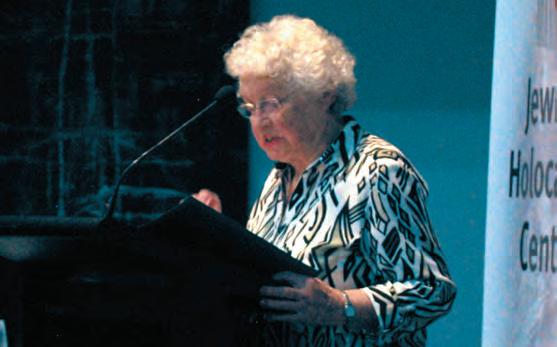
JHC Centre News 9
Saba Feniger
A Future for the Past: reflections on a conference
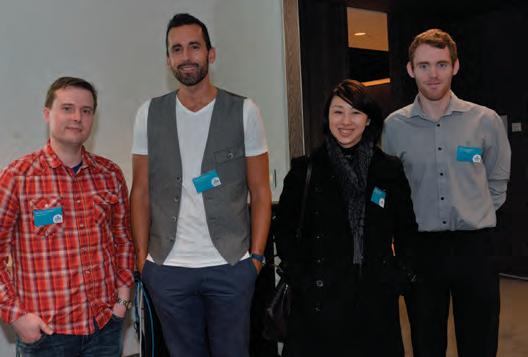
Matt Lawson, Edge Hill University
From 6–8 July 2014, the Jewish Holocaust Centre (JHC) and Deakin University hosted a three-day international conference entitled The Future of the Past: Representing the Holocaust, Genocide, and Mass Trauma in the 21st Century. Focusing on a wide range of topics, the event was the largest of its kind ever to be held in Australia. The program saw over 40 presentations from genocide survivors, academics, industry practitioners and others, with representatives from Australia, the United Kingdom, South Africa, New Zealand, the United States, France and Italy. The conference was attended by around 80 Holocaust survivors, JHC museum guides, local community leaders, and interested members of the general public.
The conference organising committee of Adam Brown (Deakin University), Danielle Christmas (University of North Carolina at Chapel Hill), Deb Waterhouse-Watson (Deakin University) and Katrina Skwarek (JHC) produced an engaging program that offered diversity and a plethora of food for thought about the nature of the Holocaust, other genocides, and human rights’ issues in the 21st century. The conference was sponsored by Deakin University’s Processes of Signification Faculty Research Group (PSFRG) and the Centre for Memory, Imagination, and Invention (CMII), and the JHC, with further support from Second Run DVD and Amalgamated Movies who made the program’s film screenings possible.
I joined the conference as a final-year PhD student and musicologist from Edge Hill University in the UK researching the effects and functions of music in films based on the Holocaust. I saw this conference as an opportunity to present my research to a large international audience, and to connect with an eclectic group of conference presenters and attendees.
Commencing on Sunday 6 July at the JHC, attendees participated in tours of the museum, where helpful guides provided personal insight into the collections and the stories behind them. It was a sobering and worthwhile experience to open proceedings, providing the humbling historical context for the conference. The suitability of the venue at which the conference was launched was reinforced by the screening of a video interview between Adam Brown and Holocaust survivor Phillip Maisel OAM, who has made an enormous contribution to the JHC through the video testimonies project.
Importantly, the subtitle of the conference emphasised the inclusion of genocides and events of mass trauma other than the Holocaust. Fittingly, the conference was launched by Mr Michael Roux, Honorary Consul General of Rwanda in Australia. Mr Roux’s thought-provoking speech highlighted the importance of scholarship and the media in exposing the truth about genocide, and chillingly stated that the seeds of genocide exist in all societies. Continuing this theme, the next session saw two survivors of the genocide in Darfur offer personal insight into how
they managed to escape the horrific events which recently unfolded in Sudan. Eltayeb Ali and Abdelhadi Matar were followed by Sandra Chestnutt, the President and Chair of the Board of the Darfur Australia Network (DAN), who spoke candidly of her experience in the Darfur region, and the difficulties faced in offering assistance.
The plenary session held after lunch involved four speakers from a range of backgrounds. Philip Cookson, CEO of Philology Pty Ltd, a company that designs digital media applications and which worked on the JHC’s interactive StoryPod platforms, spoke about the use of technology and the ethics of representation. He demonstrated how easily historical photographs could be manipulated using simple technology that is now readily available on mobile phones. He also raised issues of virtual reality, and asked ‘when does reality become too real and for whom?’ JHC curator, Jayne Josem, also spoke about the prickly subject of the ethics of representation, this time in museums. She raised the use of pictures of Jewish child victims of the Holocaust at the entrance of an otherwise dispassionate museum, highlighting the fact that their purpose was ‘to get visitors’ heads in the right place’. Sally Morgan spoke about her role in working on building a substantial repository of multimedia educational materials for the Rwandan Stories and Vanishing Point projects, and Avril Alba, whose background bridges the academiccurator divide, discussed the intergenerational and institutional transmission of Holocaust memory. It was an intellectually provocative introduction to the conference.
The first session of academic papers on the Sunday afternoon was split into two parallel panels. The first, titled ‘Sexing up the Holocaust: Gender(ed) Representations’, saw a discussion by three scholars of female identity, love stories, sex and seduction in Holocaust films and literature. During the second session, two papers were presented, on ‘Performing Narrative Memories: From Stage to Screen’, examining theatrical and filmic representations of Rwandan and Indonesian mass killings.
10 JHC Centre News
(l-r) Dr Adrian Schober, Dr Brian Johnsrud, Dr Hsu-Ming Teo and Matt Lawson
The day concluded with a screening of Andrzej Munk’s unfinished Polish masterpiece, Passenger (1963), followed by a panel discussion. The panel included two British scholars, Elizabeth Ward of the University of Leeds and myself, as well as Trent Griffiths from Deakin University. The panellists discussed the context and history of the film, and examined issues surrounding the sexuality of the lead character. In my capacity as a musicologist, I analysed the use of the film’s music. Our presentations were followed by audience discussion which continued into the evening.
The second day of the conference saw 16 papers presented on a host of topics. Held at Deakin University’s Melbourne City Centre, the proceedings began with a parallel session. One panel reflected on ‘New Media, New Memories, New Ethics’, while the other discussed how issues of complicity and culpability are negotiated in relation to depictions of perpetrators. One of the most effective papers of an exceedingly strong conference came from Brian Johnsrud of Stanford University in the USA, who spoke about his Lacuna Stories project. During the hitech presentation that followed, he reinforced the power of technology in learning about historical events. The second and third papers in this session discussed testimony and new museum ethics in Queensland, and the ‘gamification’ of Holocaust exhibits. The latter paper was delivered by Adam Brown, and focused on the StoryPods at the JHC. The parallel session saw discussion of the Adolf Eichmann trial and the creation of Holocaust narratives in the 1960s, reflections on the banality of evil in the novels of Kazuo Ishiguro, and remembering trauma in the oral histories of British former child migrants.
The ‘big screen’ was the focus of the following panel, in which the papers ranged from film studies and the adaptation of books to film to musicology. The two British speakers from the Passenger screening discussed the 2012 film Lore and the effects of film music in Holocaust film. Film was also the centre of attention after lunch, with a panel comprising papers on Hiroshima mon amour (1959) and Chitty Chitty Bang Bang (1968). The intriguing link between Kim Roberts’ paper from an architectural viewpoint and Adrian Schober’s take on the antisemitic elements of a well-loved children’s film was on the surface unconventional, yet highly enthralling. Papers presented in the adjoining room included discussions of media, trauma and biopolitics, with particular attention given to Claude Lanzmann’s well-known Holocaust documentary Shoah (1985), and the significance of music to the representation and self-representation of victims in the camps and ghettos, especially those who took part in prisoner orchestras.
The final panel of the day focused fittingly on the ongoing
effects of the Rwandan genocide, the 20th anniversary of which is being commemorated this year. Laura de Becker from the University of the Witwatersrand in South Africa discussed artworks representing the genocide, while Deborah Mayersen and Sally Morgan concluded a fascinatingly varied panel by discussing graphic novels and issues of pedagogy respectively.
The final day of The Future of the Past conference saw the presentation of more research papers covering a wide array of academic disciplines. The opening session focussed on literary representations of the Holocaust. Issues covered included the role of the child’s perspective, traumatic memory in the third generation, and the place of Nazi genocide in Australian fiction. British involvement in genocide was covered in the following panel by Tom Lawson, who discussed British museums and the process of returning Indigenous remains to Tasmanian Aboriginal communities. Steven Cooke of Deakin University concluded by discussing the 1961 Warsaw Ghetto commemoration in Melbourne. The parallel session examined trauma and testimonies, with Sean Sidky discussing the seminal works of Elie Wiesel and Mirna Cicioni exploring the works of Italian author Aldo Zargani. The final panel of the day involved papers on memory, art and identity in the 21st century. The presentations concluded with provocative reflections on autobiographical trauma, Vichy France, and affective spaces of Holocaust representation.
A packed conference room met for one last time to reflect on the conference, and Avril Alba of the University of Sydney rounded up the three-day event by providing a contemplative conclusion, but also provoking questions for one final open discussion. As the clock ticked to 5pm on Tuesday 8 July, a magnificent, inspiring conference came to a close.
As a scholar who travelled over 11,000 miles to Melbourne from the UK, I have to say that it was worth every one of the 93,600 seconds that I sat on a plane to be there! Perhaps what struck me most about the conference was the variety of academic backgrounds and papers on what may appear to be a fairly narrow field of enquiry. We had presentations given by scholars of English literature, readers of history, musicologists, architects, politicians, film studies’ students, and artists, to name but a few. It was also a delight to see the involvement of individuals from non-academic backgrounds, particularly Holocaust survivors, including twin sisters Stephanie Heller and Annetta Able, who, over ninety years old, attended all three days of the event.
While there was a large range of papers for all interests, the program maintained a general interest for everyone. Speaking personally, although musicology may seem a little removed from Holocaust Studies, I found that I was fully engaged with all the papers I heard, and was drawn into passionate debates about topics with which I had previously had no involvement. That is the value of academic conferences. Although convenor Adam Brown opened with the tongue-in-cheek provocation, ‘Conferences are a waste of time’, on the evidence of this one, I would argue that their value is vastly underestimated.
Huge thanks must go to the sponsors and organisers for keeping the discussion alive, and for ensuring that the Holocaust, other genocides, and human rights’ issues in general remain at the forefront of our minds.
Matt Lawson is a final-year PhD student and musicologist from Edge Hill University, UK.

JHC Centre News 11
Dr Alessandro Carrieri
From a Year 11 field trip to researching gender and sexual violence in Holocaust film
Deb Waterhouse-Watson
Afew years ago, I never would have thought I would be convening Australia’s largest ever conference on the Holocaust, other genocides, and mass traumas. I first came to the Jewish Holocaust Centre (JHC) on a school excursion in Year 11, which (as for many teenagers) was my first real exposure to the Holocaust. I still remember the survivor who spoke to us, and the ritualised dehumanisation she described has stayed with me. But it was not until 2011, after I finished my PhD on football and sexual violence in the news media, that I began to look at Holocaust films as part of my research. Through volunteering at the Centre with Adam Brown and coming along to the JHC Film Club, I developed an interest in how women’s experiences during the Holocaust are portrayed on screen, and the ways that women can be marginalised, and their experiences downplayed or dismissed.
Never realising just how big it would ultimately become, we decided to convene a conference focused particularly on representation, given its critical role in the memorialisation of genocides and other mass trauma. We took representation in its broadest sense, including fiction films, literature, museums, digital media, music, documentary and art, as these media all represent different ways of coming to terms with the past. Representation is also important as it helps us to make sense of the present, even when historical events are portrayed. This is one of the reasons I have chosen to focus my Holocaust research on representations of gender in fiction films.
The paper I presented at The Future of the Past conference focused on two Eastern European films that feature female gentile rescuers, and addressed the ways in which these women’s roles in rescuing Jews
were either erased or rendered insignificant compared with other concerns – usually the achievements of the male rescuer. The Polish film In Darkness (2011) is based on actual events and focuses on Leopold (Poldek) and Wanda (Magdalena) Socha, a couple who hid a number of Jews in the sewers of Lvov. Both Wanda and Leopold’s rescue efforts have been recorded in testimonies of survivors they saved, such as Krystyna Chiger’s memoir, The Girl in the Green Sweater (2008). Chiger explains that the real-life Wanda contributed to their safekeeping in numerous ways. However, the film completely erases Wanda’s contribution and instead shows her opposing her husband’s ‘heroic’ efforts to keep the Jews safe.
In my presentation, I argued that the erasure of Wanda’s contribution relates to gender-based assumptions about what heroism is. Chiger writes of how Wanda did the Jews’ laundry every week, and bought and operated a food barrow to disguise the extra food that they were purchasing to feed the hidden Jews. However, the film shows her performing none of these activities, instead focusing on Poldek moving the hidden Jews around to avoid the Nazis, and concocting clever lies to prevent them from setting mines in the sewers. Poldek is even the one who obtains the food, taking over the role of real-life Wanda. Fictional Wanda makes no real attempt to assist in the rescue. Indeed, she is almost always an obstacle to her husband’s heroic efforts.

Poldek’s rescue efforts are very ‘masculine’ – outdoors or underground and active. Wanda’s contribution is stereotypically feminine, performing domestic chores indoors. I argued that this reflects the popular belief that only masculine heroism really counts; according to the film, domestic work is insignificant. This is important for
a number of reasons. Firstly, it over-emphasises men’s experiences, which were often qualitatively different from women’s, and fails to recognise the significance of these other experiences. In addition, it perpetuates the idea that women are incapable of rescue and heroism, and that while women’s place is in the home, what they do there is of no real value.
The second film I discussed, the fictional Czech film Divided We Fall (2000), is a very different kind of film, a tragicomedy that focuses on a married rescuer couple: Josef Cízek and Marie Cizková. Marie and Josef hide a Jewish man, David, in their pantry, and the two years during which they keep him safe entail many humorous ‘close calls’, moments of slapstick and absurd humour. The debate over whether comedy is an appropriate mode for a Holocaust film is an issue that I did not have space to cover in my paper, but what I discussed in
JHC Centre News 12
Michael Roux, Honorary Consul General of Rwanda in Australia
relation to the humour was the things that it made light of, such as sexual violence and coercion.
Unlike Wanda in In Darkness, Marie is shown as a rescuer rather than an antagonist. However, she remains an overwhelmingly passive character, who is unable to follow through with expressing any desire or will of her own. Most problematically, when their collaboratorneighbour Horst tries to convince Marie to put on a dress he has brought for her and go on a picnic, she repeatedly refuses, but she is seen moments later happily doing as Horst demands. This reinforces the ‘no means yes’ myth of sexual violence. On the picnic, Horst tries to rape her, but the setting is brightly lit (a strong contrast with the rest of the film), and has elements of slapstick as Marie struggles and kicks him. Even though Marie shouts, ‘Your solution is to rape me?’ it appears more as a ‘failed seduction’ than a rape, as her repeated denials have already been shown as false.
Marie’s body is ultimately the pivot-point of the plot: her body is a passive site of reconciliation and rebirth for the Czech nation, rather than a full person with rights of her own. To prevent a Nazi from being housed with them, risking the discovery of David, Marie lies and says that she is pregnant (an impossibility as Josef is sterile.) Josef insists that the lie must be made truth, so she must sleep with David. When an emotional Marie hesitates in going through with this, Josef fearfully declares, ‘We have to – we simply have to’, and pulls David and Marie back together into the bed. His use of ‘we’ implies that he is responsible, and so he has effectively raped both his wife and David by proxy. However, again, the event is not shown to be sexually violent: slapstick makes it seem light-hearted rather than traumatic. Marie’s autonomy is again denied when Josef rescues her wouldbe rapist Horst from prison to deliver the baby without her consent. As the event enables the three men – Czech (Josef), German (Horst) and Jewish (David) – to express their solidarity, affirming Horst’s worth to the Russians, Marie’s body remains a passive conduit that facilitates the development of the brotherly bond between them. With Marie positioned as carrier of the Jewish man’s redeeming ‘seed’ rather than a maternal force, the film is concerned as much with resuscitating Czech national identity and history as it is with its implication in the horrors of the Holocaust. Indeed, after giving birth, Marie
is never seen on screen again.
By downplaying the seriousness and trauma of rape, and implying that a woman’s bodily autonomy is irrelevant when compared with men’s brotherhood, Divided We Fall denies this important part of women’s experiences in the Holocaust. It therefore reflects the way that many
Holocaust films suggest that men’s experiences are more important (sometimes even more traumatic) than those of women. It also reinforces popular myths about ‘real rape’ that still have currency today, suggesting that it is ‘no big deal’, and rape by an acquaintance can do no real harm.
In terms of the conference overall, several conference participants commented that visiting the JHC was one of the highlights, and a fitting place to begin such an important event. Another highlights was the number of Holocaust and Darfuri genocide survivors, JHC volunteers, industry practitioners, and members of the general public who attended and/or presented. It is relatively rare to have ‘non-academics’ at these kinds of conferences, which can have a reputation for being somewhat insular. However, we wanted to encourage active dialogue between people who approach the Holocaust, genocide and mass trauma from very different perspectives. We received much positive feedback about the value of these dialogues from those who had engaged in discussions at lunch and tea breaks throughout the conference days. I was also struck by
how many people sought to contribute to the discussions that followed each presentation, and very pleased that participants from diverse perspectives were able to participate. I also found the experience so positive that I did not feel depressed after talking about genocide for three days straight!
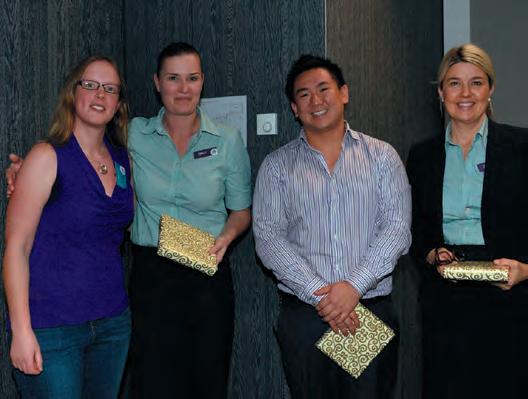
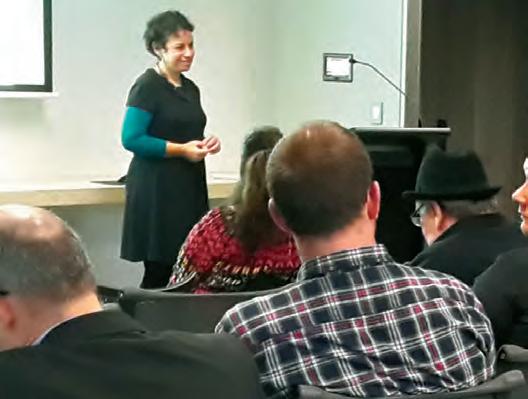
Dr Deb Waterhouse-Watson is a lecturer in Media Studies at Deakin University. She was a member of the Conference Organising Committee for the conference The Future of the Past.
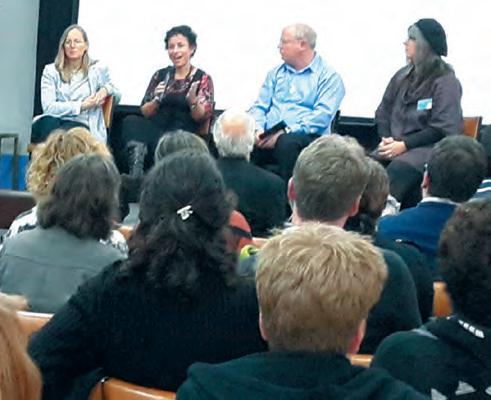
JHC Centre News 13
(l-r) Jayne Josem, Dr Avril Alba, Philip Cookson and Sally Morgan
Dr Avril Alba
(l-r) Dr Deb Waterhouse-Watson with members of the Deakin City Centre staff
What don’t we know? Unanswered questions from the Holocaust
David Silberklang

n 1 August 1941, the commanders of the various German murder units operating in the Pripet Marshes (today’s northern Ukraine and southern Belarus) received an order from SS leader Heinrich Himmler that from then on they were to select a small number of young, able-bodied Jewish men in each community for temporary forced labor. The rest – the women, children, elderly and ill – they were to drive into the swamps. The implication was clear – the Jews were to sink into the soft swamp floor and drown. Something about this order caused the commanders to hesitate momentarily and request clarification. The clarification arrived and they proceeded to carry out the order. However, the swamp floor was not so soft, and the Jews did not sink in. Nor was the water very deep; the adults were able to lift the small children in their arms, and the Jews did not drown. The killers then found themselves shooting a disorderly mass of people in the swamp, rather than neat rows of people on the edge of a pit. After several attempts they returned to their previous method of murder.
What was it about this order that caused these men, who had by then murdered many thousands of people, to hesitate? It seems that there were two related factors – a change in orders and the very nature of the order. This order was part of a shift from selective killing of Jews in the USSR to total murder of entire communities, leaving only a select few alive temporarily. Total murder, together with the specific instruction to kill the weak, women and children, gave these seasoned murderers pause.
Almost a year later, in the small hours of 13 July 1942, the 500 men of Reserve Police Battalion 101 were awakened in their barracks in Biłgoraj, Poland, and told to board their transport vehicles with their combat gear. Most of the men were in their 30s and 40s, married with children, and had seen little police action during the war. The unit was from Hamburg, an area previously known for its socialism, not its Nazism. When they reached their destination, Józefów, the men disembarked, stood in a semi-circle in the town market square, and their commander, Major Wilhelm Trapp, explained their mission. Of the approximately 1,800 Jews in the town, 300 able-bodied young men would be selected and transported to labor camps, and Battalion 101 would shoot the remaining 1,500 in the nearby woods. Trapp asked the battalion physician to explain how to kill a human being. The physician affixed a bayonet to a rifle, traced a prone figure with arms and legs spread
Oon the ground, and told the men to stand between the victim’s legs, aiming at the nape of the neck. With tears in his eyes and choking voice, Trapp told the men to think of their families being bombed by the Allies back home, all because of the Jews. But he added that he understood that this job might be too difficult for some and, therefore, anyone who felt unable to carry out the task should step forward and Trapp would give him a different assignment. Of 500 men, 12 stepped forward. During their months in Poland, the battalion engaged in the direct murder or deportation to death of some 83,000 Jews. Trapp’s offer stood, and the number of those asking not to kill remained constant.
How do we explain the striking contrast between these stories? Why did the seasoned murderers hesitate briefly when told to kill women and children, yet the raw, untested and less ideological reservists showed little hesitation? These stories point to one of the central questions from the Holocaust. What motivated the murderers in the field?
Similarly, long-standing questions trouble us regarding Jews’ reactions to the murder. We know from West German trial records that police and SS men involved in the deportation of the Jews of Lublin to Bełżec in March and April 1942 found after they returned to the deportation operation on 31 March following a two-day logistical pause that ‘all the Jews had gone into hiding’. We know from Jewish records that some Jews had managed to get scraps of information through various channels. We also know that the deportation operation was extremely brutal and murderous. While some 30,000 Jews were deported to Bełżec and murdered there immediately upon arrival during the four-week operation, an additional 2,000 were shot in the streets. The combination of the horror of the deportation operation, the memories of the brutal forced-labor camps at Bełżec in 1940, and the bits of information that some had obtained led the Jews to hide, and years later the Germans remembered this because their job had become much more difficult.
Several months later, when the deportations began from Warsaw to Treblinka on 22 July 1942, some of the remaining Jews in the remnant ghetto in Lublin stood in line at the Judenrat office in order to telephone their loved ones in Warsaw. As the survivor Ida Glickstein recalled, the young man ahead of her in line pleaded with his brother in Warsaw to hide their mother, but the brother assured him that their mother was safe because he was a policeman and she had work papers. Many Warsaw Jews tried to hide during the two-month deportation operation, but the operation seemed to progress much like the earlier Lublin operation prior to 31 March.
These two stories point to fundamental questions regarding the connection between information and victim
JHC Centre News 14
David Silberklang
behaviour. By the time the deportations had begun in Warsaw, much information and many rumors about mass murder elsewhere had reached the ghetto. What is the connection, if any, between information and behaviour? Did information have an impact on Jewish reactions to the Holocaust?
What Don’t We Know?
Before discussing what we do not yet know about the Holocaust, we should remind ourselves that we know a great deal. There has been much good research and many good articles and books on many aspects of


Gross‘s book Neighbors (2000), but most of Poland has not yet been researched on this question, and it would still be difficult to say definitively whether the murder in Jedwabne represented the rule or the exception. Similarly, we do not yet have sufficient research on collaboration with the Nazis among local populations, or an overall picture and comparative analysis of this phenomenon.
The majority of the Jewish communities affected by the Holocaust have not yet been researched, nor do we know the value or whereabouts of Jewish property and belongings stolen or looted. The identities of the large majority of the perpetrators remain unknown, and the identities of more than 1,500,000 Jews killed in the Holocaust are still unknown – and many of these will never be known.
Our understanding of the Jewish experience in the Holocaust is based on the diaries and letters of the dead and the accounts of the survivors. But what about those who were killed? What did they think during their last moments before death? What did they feel inside the gas chambers?
If one of the goals of studying the Holocaust is to learn, collectively, how to prevent such things from recurring, then we need to ask ourselves if, nearly 70 years after the end of the Second World War, we are on the way to learning to recognise warning signs and to engage in prevention. Have we learned how to create a world where societies have developed internal checks against such things?
Sources, Subjects and Lingering Questions
the Holocaust. This research in many disciplines has provided us with historical information as well as insights into perpetrators’ motivations; Nazi decision-making towards the ‘Final Solution’; Jewish responses to the Holocaust, including amidah (resistance), undergrounds, attempts at armed resistance, the Jewish councils (Judenräte), and more; and some Jewish communities. Two recent major encyclopedias of the ghettos that can help us begin to learn about the fates of many communities, particularly in Eastern Europe are The Yad Vashem Encyclopedia of the Ghettos in the Holocaust (2009), and The United States Holocaust Memorial Museum Encyclopedia of Camps and Ghettos, 1933 –1945, Volume II, Ghettos in German-Occupied Eastern Europe (2012).
So, what don’t we know? We can point to a number of major studies still to be done. For example, there is no overview of the Holocaust in Poland. Whereas there are many books and articles about aspects of the Holocaust in Poland, the comprehensive study that could try to tie the story together, lay out the central subjects, and serve as a basis for future research has yet to be written. Various aspects of the Holocaust in Poland have merited only limited research to date. There is as yet no book on the Generalgouvernement, or on Western Galicia, or on the Jews of Eastern Galicia. There are two overviews on the Holocaust in the USSR (by Yitzhak Arad and Ilya Altman) but almost innumerable questions and regions not yet researched. There is no overview of the Holocaust in Greece, and only one attempt at an overview of Jewish forced labour across all areas of Nazi control (by Wolf Gruner). The attitudes of local Polish people to the persecution and murder of their neighbours has merited more detailed, fine research in the last few years, an outgrowth of the heated debate set off by Jan Tomasz
Since around 1990, numerous archives have been opened to researchers. These archives are in the former Soviet Union, other post-communist countries, the International Tracing Service in Arolsen (Germany), France, Switzerland and other places. Parallel to the gradual opening of these archives, scholars have blazed new
research trails. We now have a much better picture of the roles of technocrats, local and regional officials, and others in the Holocaust; we have advanced in research into the economic aspects of the Holocaust; we know more about various localities and regions; research into Soviet reactions to the Holocaust has begun; and many other new avenues of research have developed.
Continued next page
JHC Centre News 15
(l-r) Warren Fineberg, Dr David Silberklang, Johnny Baker, Joey Borensztajn and Julie Borensztajn
(l-r) Jane Rapke, Goldie Birch, Peter Singer, Simone Markus and Alon Cassuto
The sheer volume of documentation that is available to the researcher has increased manifold, and with modern technology, this documentation is becoming increasingly accessible from computers around the world. Of course, we must wonder how a researcher will deal with a deluge of millions of accessible pages on a given topic. Still, major questions abound, while others have yet to be addressed.
In October 1992 Yad Vashem sent one of its senior scholars, the late Dr Shmuel Spector, to Moscow to take a first look at a new archive that was being opened to Western scholars – OSOBI. I was among the many young researchers lined up outside his office to discuss their particular subjects with him and to ask him to check if there was relevant material there that would require a trip to Moscow. When Spector returned, I went to see him and, in response to my question regarding material on my topic, he laughed. He described being met at the airport and driven to a five-storey building. He imagined that the archive was within those five storeys, but as it
turned out, the archive was in the many storeys below ground. He had found 27 kilometers of shelving, tens of millions of pages of documents, some of which were relevant to the Holocaust and some not. Every page was professionally preserved. He then went on to explain that this was but one of numerous archives of this size scattered across the former USSR, and he concluded: ‘If all the researchers working on this subject live to be 120 and work six days a week, twelve hours a day, it will take us 100 years just to turn the pages.’ Since then many more archives have become accessible, and hundreds of millions of pages of documentation await the examination of scholars. By Shmuel Spector’s estimate we have some 78 years to go before we will have turned those pages. What don’t we know? Quite a lot apparently. Dr David Silberklang is Senior Historian at the International Institute for Holocaust Research at Yad Vashem, Jerusalem. He spoke at the Jewish Holocaust Centre in April.
As part of the 30th anniversary of the Jewish Holocaust Centre, Child Survivors of the Holocaust have created a time capsule to commemorate their history in Melbourne. The time capsule was sealed at a closing ceremony at the Jewish Holocaust Centre in May.
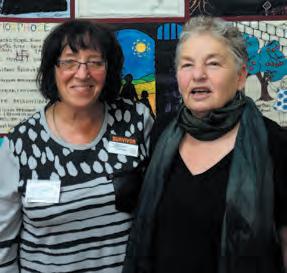
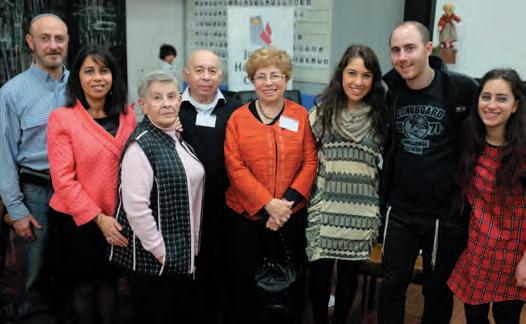

Memorabilia, important documents, photos, letters, family trees and memoirs of child survivors have been placed in a special archive box decorated by artist Daniel Kogan, a child survivor, artist and entrant to the prestigious Archibald Prize.
The ‘closing’ ceremony was attended by child survivors and their families, including grandchildren and other
young people. In fifty years time, in 2064, it is planned to hold an ‘opening’ ceremony to reveal the contents of the time capsule, and it is intended that the guest list for the ceremony will include the names of those young people who were at the closing ceremony. Child survivors hope that their time capsule with their personal accounts of their memories, past and present, will serve as a reminder of the events of the Holocaust. In 2014, child survivors can only dare to imagine the life changes of their grandchildren and young friends who were present when the time capsule was closed. In 50 years’ time, probably with children and grandchildren of their own, today’s young people who witness the opening of the time capsule should be able to recall the day when they stood with their loved ones, and honoured the survivors’ courage and determination to live. Many child survivors found freedom at the end of the war, but faced life alone. The time capsule not only documents their tragic past, but contains memories of their triumphs as they created new families and a new future, far away from their homeland and the past.
JHC Centre News 16
(l-r) Stan Marks OAM, Eva, Peter, Catlin and Alistair Marks
Child Survivors of the Holocaust Melbourne seal a time capsule to be opened in 2064
(l-r) Ashley West, Vera West, Alice Halasz, Peter Handelsman, Anne Handelsman-Braun, Alana, David and Simone West
(l-r) Rona Zinger and Marietta Elliott-Kleerkoper
Leon Jedwab –a survivor from Zagorow

Freda Hodge
Leon Jedwab’s narrative began in the little-known town of Zagorow in the Konin district of Poland. Jews had lived in Zagorow since the end of the 18 th century, and had created a close-knit community. However, the strained relationships between Poles and Jews led to pogroms and general harassment of the Jews, especially in the years before the Second World War. During 1936 and 1937, boycotts of Jewish businesses and pogroms took place, wreaking havoc among the Jewish residents.
On 6 September 1939 the town was occupied by the Nazis who immediately instigated measures against the Jews and reduced them to an existence of total deprivation and terror. Jewish homes and possessions were looted, and Jews were herded into the ghetto, established in 1940. The ghetto isolated the Jews from the outside world, and made it easier for the Germans to control them. They experienced starvation and physical torture, as well as slave labour. One of the first methods used by the Nazis to humiliate the Jews was to have all those between 15 and 50 years of age clear the grass in the marketplace using their own cutlery. They were mocked as they worked and they were physically manhandled.
Synagogues were destroyed, and sacred Jewish texts were desecrated. The Nazis brutalised the inhabitants of the ghetto into total submission. They were ordered to sew the Star of David onto their garments and to observe a curfew from 6:00pm to 6:00am. Jews were brought in from surrounding towns and villages such as Kleczew, Golina, and Wilczyn, in order to facilitate Nazi plans for the ‘Final Solution’. Eventually, approximately 3,000 people inhabited the overcrowded ghetto. Up to 15 people were accommodated in one room. Under these appalling conditions, morality and even humanity were often compromised, and the suffering inhabitants were driven to fight even among themselves. The locally elected Jewish Aid Committee tried to take care of the newcomers and sought support from the American Joint Distribution Committee in Warsaw.
Jews who applied to leave the ghetto were forced to give up all their assets and valuables. The Judenrat was ordered to form work crews as slave labour in the construction of roads and railway tracks, agriculture and building for the Germans. However, there were frequent deportations, with Jews being loaded into grey trucks that were completely sealed. The prisoners were then gassed by carbon monoxide from the exhaust pipes fed into the sealed trucks. This was an experimental phase for the Germans, who sought an efficient method for killing large numbers of victims. As this method was deemed slow and cumbersome, the Nazis established the first death camp, Chelmno, headed by Hauptsturmfuehrer
SS Herbert Lange. In the genesis of the ‘Final Solution’, the experimental gas trucks used to eliminate the Jewish population played a pivotal role in the lead-up to the establishment of extermination camps.
By the end of October 1941, the German authorities had decided to liquidate the Zagorow ghetto. They murdered all the inhabitants in the nearby forests of Kazimierz Biskupi. Jews were loaded onto trucks, 50 people at a time, and transported to the killing grounds in the forest. There, non-slaked lime was placed in the pits which had been dug. Naked prisoners were ordered to jump into the pits and water was poured over the mass of screaming humanity. They were literally boiled alive.
Leon’s personal narrative is a remarkable story of a man who overcame and survived unspeakable experiences. He and his four siblings were born into an Orthodox Jewish family who spoke Yiddish, German and Polish. His father, Ide, ran a general store in Zagorow together with his sons, while his mother, Szejna Rajsel, raised her family and also helped in the shop. In 1938, when it became evident to Leon’s family that Jews were in grave danger in the face of the menacing threat from Germany, his father and two older brothers, Abe and Max, emigrated to Australia. It was impossible for the rest of the family to join them, as Hitler had already invaded Poland. Leon remained in Poland to take care of his mother and siblings.
Einsatzgruppen had entered the Konin district before the German troops arrived, and commenced their program of annihilating the Jews. In September 1941, the Germans began to carry out Aktions, and Leon’s mother, brother and sister were all transported to the Kazimierz Biskupi forest where they were murdered. Leon was selected to work in the Hohensaltza labour camp where he experienced brutal beatings. He was then moved to Lodz where conditions were even worse than Hohensaltza. In 1943 he was taken from Lodz by cattle car to AuschwitzBirkenau. Miraculously, he and his close friend Chaim survived Auschwitz, but Leon was sent to five other camps before being forced onto the death march to Buchenwald in 1945. There he was finally liberated by US armed forces. Leon’s own words best describe his attitude to all that he experienced: ‘I never lost hope during those five long years in the camps.’
Leon was reunited with his father and brothers in Australia in 1946.
For further details about Leon Jedwab’s story, please visit his website, www.leonjedwab.com.
JHC Centre News 17
Leon Jedwab with his portrait, titled ‘Leon Jedwab #144768 Holocaust Survivor’ painted by Ross Cockle and entered in the 2013 Archibald Prize. Photo: Peter Haskin, AJN
An autumn journey
Gary Gray
None of us knew the name of those birds that spoilt our game that Tuesday morning.
‘They were not crows,’ Margie maintained. They were smaller.
‘But Gary, God, I was scared.’
I looked so much forward to my tennis at Caulfield Park Tennis Club, but those birds really ruined our game of doubles that morning. Flying in pairs over our court, so low, just above our heads, with such velocity and that high-pitched whistle – disappearing towards the new pavilion, only to come back a few seconds later, this time even lower, with even greater speed and noise, as if they were playing some sort of hide and seek with us, frightening Margie and our opponents on the other side of the net.
Finally, when they were gone, my memory somehow took me back to Poland, autumn 1939. ***
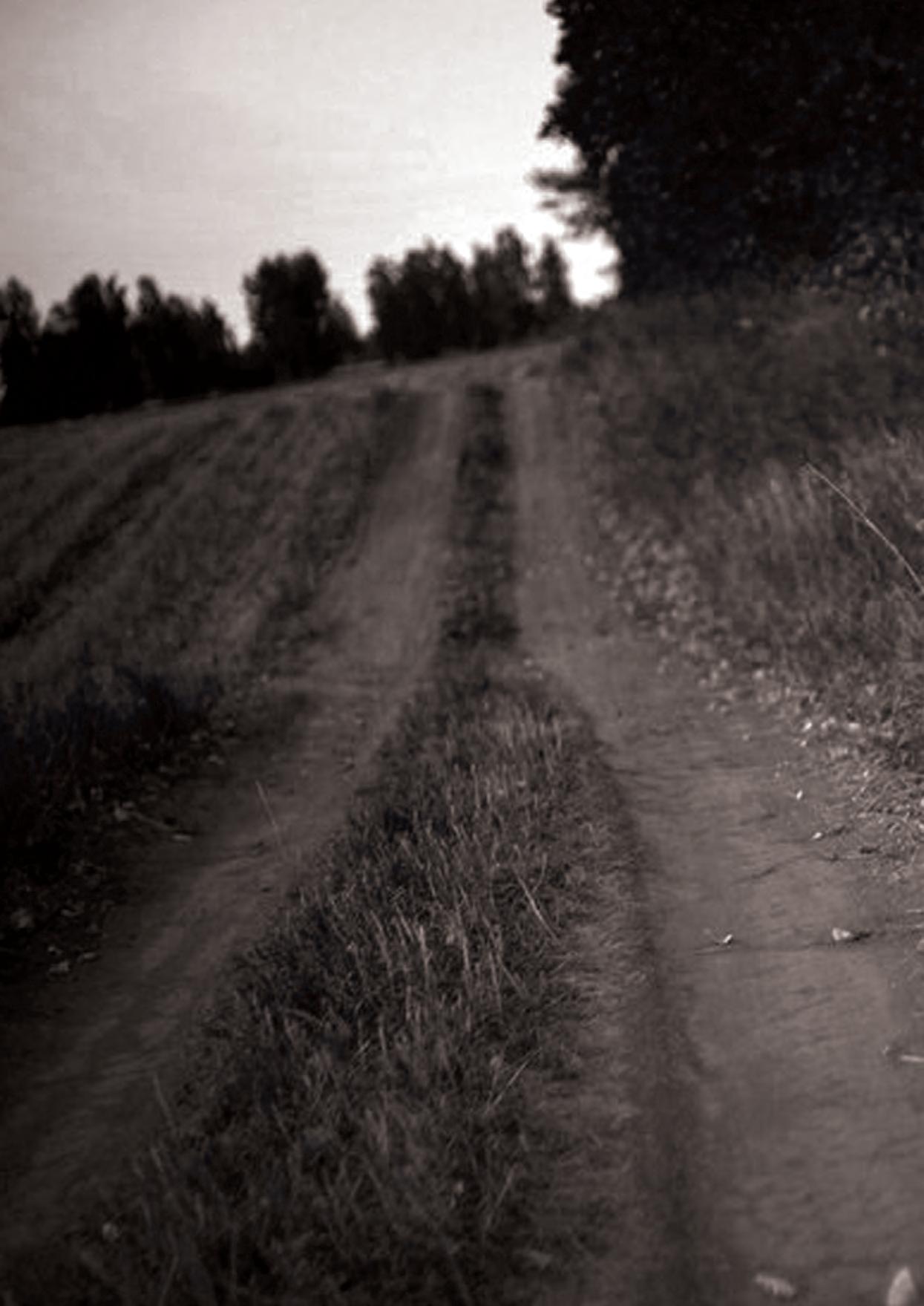
The flat horse carriage (platform we called it) actually belonged to my uncle Moritz who used it to transport crates of soft drinks he produced in his small factory. Now it was loaded with some domestic gear and, on top of it my mum, Uncle Isidor, my little sister Ada and three other cousins.
My dad wasn’t among us; he was mobilised to the Polish army just a few days before, at the very beginning of the war. With one horse attached to the platform, my uncle sat on the front seat holding the reins.

We were of course, like many other families, trying to escape from our district very near the Polish-German Silesia border, trying, so to speak, to get away from German forces.

‘Dad,’ my older 16-year-old cousin Moniek asked his father, ‘do you really think we can escape in this?’ pointing to the lone horse schlepping our platform.
‘Moniek, we only want to get to Miechow, not to be caught in Sosnowiec. Anyway, can’t you see so many other families in front of us doing the same thing?’ Uncle concluded, pointing out to a kilometer-long cavalcade. ‘In Miechow, we can stay with our relatives.’
‘What’s that noise?’ someone asked. Within seconds we saw people jumping out of carriages similar to ours, hiding in the ditches on both sides of the road. Here they came! They were small planes in some sort of formation high above us, some of them leaving the formation, flying along the road fifteen metres above us, with a terrible frightening noise.
‘Hide your heads and pray,’ someone screamed to his family.
We could hear some short volleys of a machine gun hitting the road, not really aiming at the ditches. What a relief when we saw them flying away, disappearing behind surrounding hills, but returning again, flying even a bit lower than before, but still not aiming at us.
‘Children,’ uncle announced some hours later. ‘We have to stop somewhere on a side road, we can’t travel at night and we have to let the horse have a bit of a rest.’
The prospect of spending a night on the platform in the open air didn’t exactly excite us youngsters. We all knew that the well-known golden Polish autumn meant warm days and very cold nights.
‘Why do we do this?’ Moniek whispered in my ear. ‘Doesn’t Dad realise that before we reach Miechow they will catch up with us?’
Somehow uncle overheard this and, sounding angry, went on, ‘You don’t know why we do this? You haven’t heard or read what they intend to do to us? They will be merciless, that’s why we are trying to get away.’
‘Now,’ he continued, ‘When Churchill declared war on Germany a few days ago, England promised to come to Poland’s help which will efscher bring the war to a quick end. We didn’t speak Yiddish at home, we actually didn’t know that efscher meant maybe, but Auntie Andja who had just joined us, repeated ‘Omein, amen.’
Anyway, cuddling up with some feather doonas and other bedclothes, we slept all night and then began the second day of that strange escape.
‘What’s that noise, what is it?’ Motek, my youngest cousin, interrupted our silence. ‘I heard it before,’ he said ‘But now it’s getting louder and louder, sort of closer and closer to us.’
Somehow there were not too many other refugees around us when our horse schlepped us slowly to the top of the hill, and when we reached the top we found out where that noise was coming from. A column of a sort of tank battalion (ein Panzer division, they call it in German). A few tanks, followed by a heavy-duty army personnel carrier with soldiers on it, and a few motor cycles with a soldier driving each and another soldier sitting in the side car holding on to a machine gun fitted to the front of the side car.
What we saw made us shiver with panic. How scared we all were, so scared, especially my little seven-year-old sister Ada and her seven-year-old cousin Lucia.
On our first day of the escape we saw some Polish army units going the other way to face the enemy. They looked pathetic, most of them on foot, a horse schlepping some artillery guns. We saw units of cavalry with rifles on their backs and sabres attached to the sides of the rifles.
JHC Centre News 18
‘God only help us!’ my uncle exclaimed when from a distance he saw some examples of the German army and compared them in his mind with the Polish army going to face it. ‘God only help us!’ repeated Uncle when he saw that approaching mighty army about to face a Jewish family on horse platform. They were about one hundred metres away from us. They didn’t seem to be bothered; they didn’t even slow down or take any notice of us. Unfortunately, however, when the first noisy tank passed us, it frightened our horse into a frenzy that sent our platform and all of us into a deep ditch, leaving the platform half overturned. We all screamed as we landed in that ditch.
‘God,’ I said to myself, feeling the urine running down my trousers when I saw the soldiers’ transport vehicle stop and the motor cycles with the machine guns stop. They ran towards us silently with some sort of organised discipline, and a few of them did the most logical thing – they unhooked the horse from the platform and took it aside. A few others, three or four soldiers, helped to straighten out the carriage. Two or three others left and brought back a long steel cable, attaching one end to our platform and the other to the back of a tank. They gave a signal to the tank and it moved forward. Within a few seconds the platform stood firmly on the road.
The other soldiers brought our horse back and attached it to the platform and they told my uncle to keep going. My uncle stood there like the rest of us, like dummies with our mouths open and, if I remember correctly, with wet eyes.
The whole military-style operation took no more than about five minutes. Some soldiers helped us to climb back onto the platform and then left.
I can’t really remember how long it took us, sitting on the platform, to come to our senses, to recover from the whole thing and to overcome the total confusion we were facing. However, what I do remember is my uncle, looking above as if saying ‘thank God’, then turning around to us saying, ‘We are going to turn around and go home. What those fellows did gives me hope that somehow we will manage.’
‘Es vet shoin zayn git (everything will be alright),’he said in Yiddish. ‘It will be good with God’s help, it will be good.’ How wrong my uncle was!
PS: ‘You see Margie, those birds flying over us didn’t really scare me in the sense that they could harm me. What scared me was that they would bring my memories back to what happened at the beginning of that war which swallowed my family and so many others.’
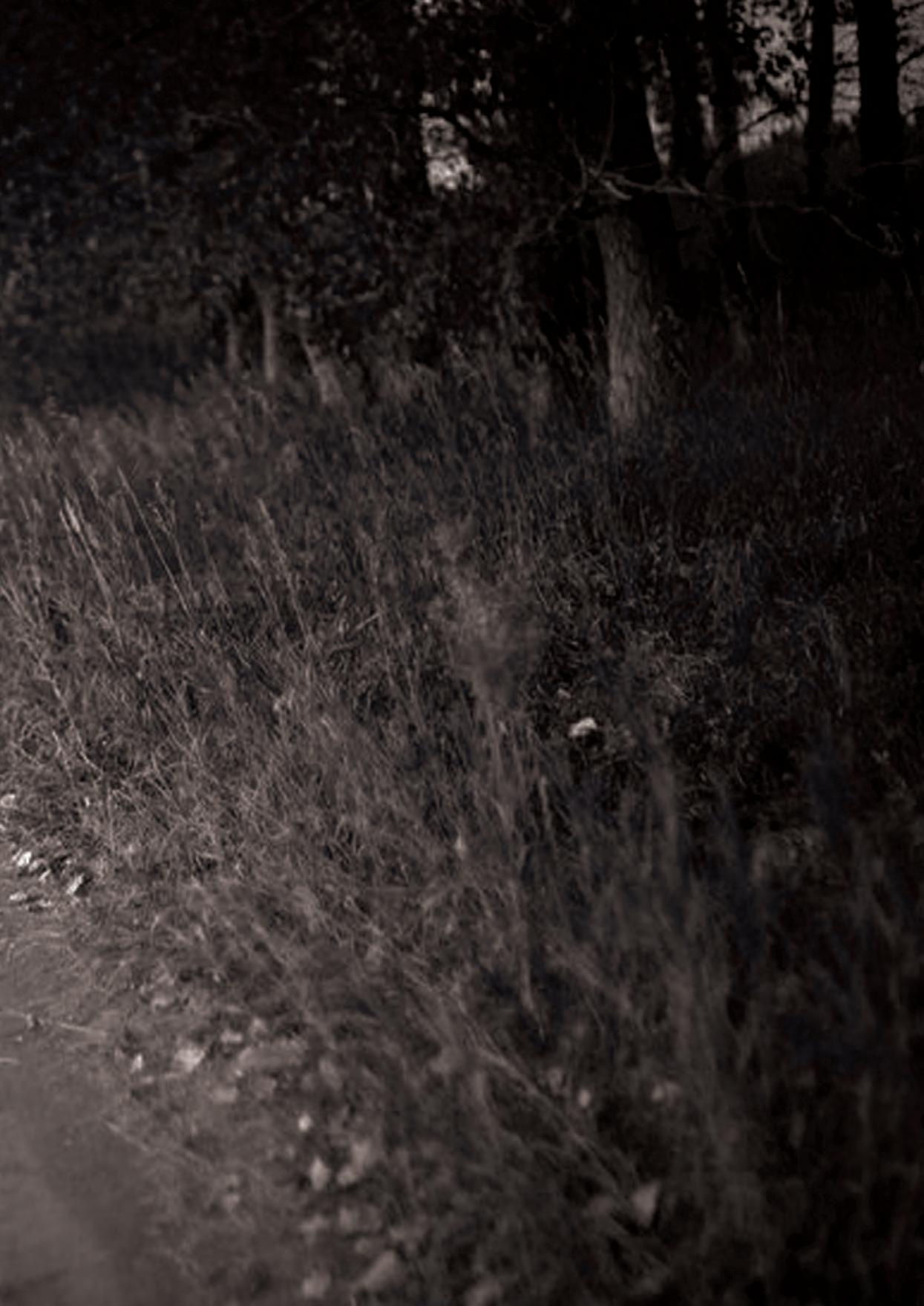
The Jewish Holocaust Centre hosts a Welcome to Country and Smoking Ceremony
On 22 June, a Welcome to Country and Smoking Ceremony was held at the Jewish Holocaust Centre (JHC) to further the understanding and connections between the Centre and Aboriginal communities.

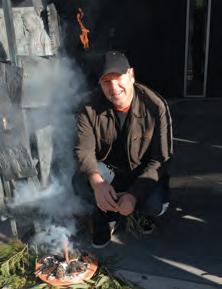
Viv Parry, a JHC Board member who has spent the past three years supporting Aboriginal organisations for those in recovery, brings each group to the JHC to understand the significance of the Holocaust and to honour the memory of William Cooper. The Aboriginal visitors learn that they are not the only minority group to have suffered discrimination, brutality and family tragedy. The testimony given by Holocaust survivor Moshe Fiszman and other survivors inspires the Aboriginal men to embrace life, even in their darkest hours.
The Smoking Ceremony was well attended by Holocaust survivors, members of the Jewish community and Aboriginal people from across Victoria. Special guests included
Senior Elder and Boonwurrung Foundation CEO, Carolyn Briggs, Senior Boonwurrung Representative, Dean Stewart, Auntie Jacko, Commissioner of the Victorian Multicultural Commission, Dr Teresa De Fazio, and Chairman of the Victorian Equal Opportunity and Human Rights Commission, John Searle.

Dean Stewart began the smoking ceremony, explaining at length the ancestral meaning of the various leaves, bark and branches which formed the basis of the fire he kindled. Dean said, ‘I am greatly honoured as a Victorian Aboriginal man to strengthen and share some of the spirit and connections of the ancestral Boonwurrung custodians.’ Carolyn Briggs then described the way her people lived, hunted and wandered across the land over many tribal boundaries which form the Kulin Nation, extending across the two bays of Port Phillip.
To end this historic ceremony, those present were invited to take a gum leaf from the River Red Gum tree and place it on the open fire, and as the smoke spiralled upwards, they were asked to connect with their own personal life force. Attendees then entered the Holocaust Centre with a deeper understanding of this significant indigenous ceremony, which provides a spiritually healing pathway for all who participate.
JHC Centre News 19
(l-r) Carolyn Briggs, Sula Rozinski and Auntie Jacko
Dean Stewart
Australian reflections: one year of Holocaust Memorial Service
Adam Thalhammer
My work at the Jewish Holocaust Centre (JHC) as a representative of Austrian Service Abroad has drawn to a close, and I would like to share some thoughts about it with you.
I grew up in the town of Feldkirch in Austria’s westernmost state, but my background is half Australian. Every other year, I was able to visit my grandparents and other relatives in Melbourne, which gave me the desire to return for a longer stay. The opportunity presented itself when, at 18 years of age, it was time for me to decide how I would discharge my compulsory national service. While the two standard choices – to complete either six months of military training or nine months of community service – would have been the most straightforward, I searched instead for a more challenging alternative, and discovered the Austrian Service Abroad program. As this would allow me to learn about the Holocaust and contribute to its remembrance, while at the same time exploring my talents and developing my skills before studying at university, I applied immediately.
In the two years that followed, I became involved in one of the non-government organisations responsible for managing the Austrian Service Abroad program. This included joining a weekly online conference, visiting Auschwitz and Theresienstadt concentration camps, and working with Dominik Armellini, my predecessor at the JHC. During the year before my departure, I was responsible for managing the organisation’s activities in the region, while completing a course in information technology at a technical secondary college.
Less than a month after completing my Matura (the Austrian university entrance exam), I arrived at the JHC where, under the supervision of Rae Silverstein, I have worked on a range of projects. These included translating German documents from the Centre’s collections, providing reliable IT support and raising the Centre’s online presence in the social media. I also assisted Julia Reichstein with the Library goes Web project, which will eventually result in an online catalogue of survivors’ memoirs and other library resources. I was able to use my IT skills to assist in the development of this project within the context of the JHC’s existing content management system and planned software upgrade.
It has been gratifying to assist in expanding the Centre’s online presence in many new communication channels.
On Facebook, we are now publicising all upcoming events, sharing current developments and publishing the comments that students and other visitors leave after reflecting on their experiences. On Twitter, we have finally established a growing base of followers and connected with many other Holocaust memorial organisations, as well as museum visitors. Our YouTube channel has been revamped to encourage online engagement and to widen the reach of our newsletter using video annotations, and we have begun a new video series entitled ‘Curator’s Corner’. I have also been able to streamline our listings on Google Maps, Bing Maps and particularly TripAdvisor, where we have received many outstanding reviews, achieving a ranking as Melbourne’s Number 23 attraction and a rating of 95%. Additionally, visitors can now find our opening hours and other information more easily on their preferred mapping service.
I was particularly honoured to participate as operations manager in the planning and implementation of the Centre’s enormously successful 30 th anniversary gala dinner in May. I worked closely with the range of people and organisations involved in organising the event, providing me with a fantastic opportunity to delve into real-world event management, and a valuable experience for the future.
I have acted as photographer at a number of JHC functions, and in July, I took part in the The Future of the Past conference organised by Deakin University in cooperation with the JHC. At the conference I was privileged to learn about the breadth and depth of research on the difficult subject of ‘Representing the Holocaust, Genocide, and Mass Trauma in the 21st Century’. I also had the pleasure of accompanying Director of Education, Lisa Phillips, to the annual conference of the History Teachers’ Association of Victoria.
My year at the Centre seems to have passed in a blink, yet it has been a privilege to work alongside the many outstanding individuals who put their hearts into running this amazing institution. But above all, I appreciate the valuable time I have been allowed to spend with our incredibly hard-working Holocaust survivors, whose stories will remain with me forever. They are the living example of what it means to do away with hatred and prejudice and embrace a society of tolerance and understanding.

JHC Centre News 20
Moshe Fiszman and Adam Thalhammer
Totally Unofficial:
The Autobiography of Raphael Lemkin
 Edited by Donna-Lee Frieze
Edited by Donna-Lee Frieze
Reviewed by Bernard Korbman OAM
Imust immediately disclose my bias. Raphael Lemkin is one of my revered heroes, so that when reading Lemkin’s autobiography as edited by Dr Frieze, my critical and analytical lenses were sharply focused.
What I discovered in reading Dr Frieze’s book was a work of scholarly brilliance. The following appears on the jacket of the book:
Although Lemkin died alone and in poverty, he left behind a model for a life of activism, a legacy of major contributions to international law, and — not least — an unpublished autobiography. Presented here for the first time is his own account of his life, from his boyhood on a small farm in Poland with his Jewish parents, to his perilous escape from Nazi Europe, through his arrival in the United States and rise to influence as an academic, thinker, and revered lawyer of international criminal law. Many reviews regarding Frieze’s book focus on the narrative of the autobiography, summed up above, which I suppose is to be expected. However, what those particular reviewers omit is the erudition, insight and understanding of Lemkin as a jurist, Lemkin as an historian, Lemkin as a philosopher and Lemkin as a visionary. Through her research, as demonstrated in her notes, appendixes and
Lodz Ghetto: the Strength of Hope: an online Lodz Ghetto exhibition in memory of Bono Wiener
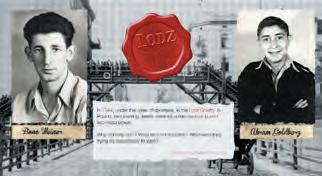
The Jewish Holocaust Centre (JHC) has developed an interactive web page designed to showcase material from the JHC collection related to Lodz Ghetto. This project was part of an initiative funded by Pinchas Wiener in memory of his brother Bono, one of the founders of the Centre.
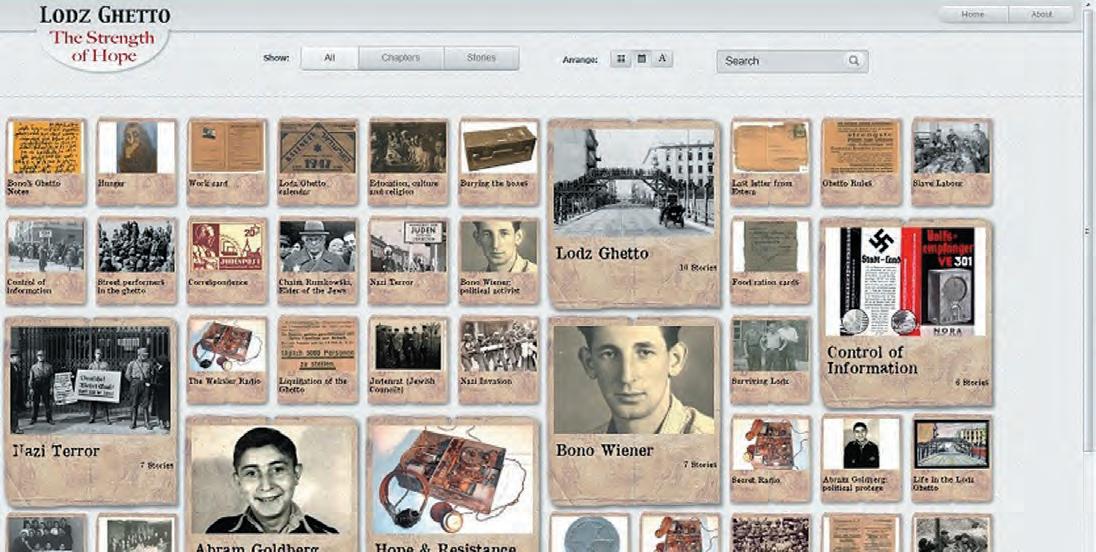
The interactive tells the incredible story of Bono Wiener, a politically astute young man involved in the Bund socialist movement in the Lodz Ghetto, who had the foresight to bury significant documents while in the ghetto, just prior to its liquidation. Bono was assisted in this and other resistance activities in the ghetto by Abram Goldberg, long-term contributor to JHC, Board member and still an active museum guide.
bibliography, Frieze is able to add depth to the personality, character and the modus operandi of Raphael Lemkin.
Frieze presents us with Lemkin the man. This is no mean feat, as Lemkin’s autobiography was not fully completed. There were a number of drafts, and a great deal of his writings dealt with the machinations of the Genocide Convention. However, through thorough and critical investigation of documents, Frieze has been able to bring to light the conversations, arguments and debates in which Lemkin participated with the key historical figures involved in the Genocide Convention.
The Convention on the Prevention and Punishment of the Crime of Genocide was ratified by the United Nations in 1951. Interestingly, some of the major issues of dissention, dispute and challenge in the charting of the convention are still in dispute today, namely, the sanctity and sovereignty of the nation state and its borders, and the difference between murder, no matter on what scale, and genocide, which does not necessarily include murder as a weapon. The strength of Frieze’s work lies in her ability to collect diverse sources of information, to bring them together with the original autobiographical works left by Lemkin, and to pay homage to a man she obviously admires greatly.
I would recommend this book to academics and the general public alike. After all, the problems of genocide and people’s capacity for inhumanity are as relevant today as they have been from time immemorial. It is therefore befitting that one of humanity’s greatest champions has a champion of his own in Donna-Lee Frieze.
Raphael Lemkin’s legacy will live on as long as civilised society prevails.
The buried material documented the incarceration, slavery and starvation of Jews in the Lodz Ghetto. The JHC online exhibition reveals a sample of this primary source documentation as it outlines the history of life in the ghetto, from its creation to its liquidation in August 1944. Among the items buried were Nazi posters that had been glued to the walls informing ghetto occupants of food rations. There were also more sinister posters demanding that families report for deportation to work in other camps, when in fact these families were to be sent to Auschwitz. The exhibition also includes a fascinating story about the illegal radio with which Bono secretly listened to reports from the outside world, news which he would pass on to others to give them the hope they needed to believe that they could survive the terror of life in the ghetto.
The exhibition is on the JHC website at jhc.org.au under the heading ‘Museum & Collections’ on the home page.
JHC Centre News 21
BOOK REVIEW
on March of the Living
After participating in the 2014 March of The Living (MOTL) program, many people have asked me, ‘How was your trip?’ This has not been an easy question to answer, since what I experienced was so much more than a sentence will allow me to express. There is no doubt that the highlight for me during the MOTL program was the ability to be present when participants gave their very personal testimonies at different stages of the journey. I felt extremely privileged to be able to listen to and reflect on their very personal accounts of an horrific event in history. Most uplifting were their stories of resilience.
camps can remember the men who walked through the huts comforting others, giving away their last piece of bread. They may have been few in number, but they offer sufficient proof that everything can be taken from a man, but one thing – the last of the human freedoms – to choose one’s attitude, in any given set of circumstances, to choose one’s own way.’
While this invaluable MOTL experience has provided some answers for me, it has also generated many new questions. The two key messages I have immediately taken from my experience are, first, never forget, never again; and second, the importance of learning how we as leaders and community citizens develop the courage and the wherewithal to challenge hatred. To challenge hatred we must be fearless in voicing the opposing opinion; to make sure that decisions are well thought out; to ensure the wellbeing of all; and to have the ability to uplift people, to motivate people – not through fear, but through compassion and humanity.
Racial hatred is an ugly cancer in any community and while informed OECD governments make all the right political noises about antisemitism, it is in our homes that education must begin. Children reflect the values of their parents, not governments.
Before I attended the MOTL, I read a book titled Irreversible What particularly resonated with me was Holocaust survivor Roman Kent’s reflection. Asked if he believes in God, he says, ‘I believe in the goodness of man. I judge people not on their religion, but on who they are and how they act. And if we speak about religions, I would like to add one more to the Ten Commandments. The 11th commandment should be: ‘When you see evil, do something.’
Most evil happens when people are bystanders. Doing nothing allows evil perpetrated by an individual or a group of people to prevail. A single injustice to one should be viewed as an injustice to all. The Righteous Among the Nations are the moral example of what could be done, but what humankind mostly failed to do.
At Jewish Care, I often say ‘the standard you walk past is the standard you accept’ and that leaders ‘do what is right, not what is easy’. In life, we are all leaders. Everyone has someone looking to them for moral direction – a colleague, a child, a friend. Leadership is a great privilege, but also a great responsibility.
The Jewish community has survived the worst of human behaviour, deceit, distrust, exploitation, violence, theft, abuse and murder. Yet in spite of this persecution there exists a democratic national Jewish state and we enjoy a highly engaged and liberated Jewish community globally. I wrote an article a couple of years ago about the debilitating effect fear can have on an individual, paralysing one into inaction – to be a bystander in what one knows is ethically or morally wrong. The question for me is how can a whole community, even an entire country, be paralysed by fear?
I regularly reflect on the impact of leadership, whether in the context of my work at Jewish Care Victoria, at home as a parent or in my private relationships with friends and family, and I firmly believe that fearless leadership is critical for a good society. Conversely, fear, inaction and indifference erode the foundations of what I believe to be the pillars of a strong and compassionate society.
Victor Frankl, Austrian psychiatrist, neurologist and Holocaust survivor, wrote, ‘We who lived in concentration
So, I ask that people challenge their perspective. When it comes down to it, empowerment is usually nothing more than a choice. Be willing to believe that you are stronger than any challenge that arises. The more you are focused on releasing fearful thoughts and strengthening your belief in yourself, the less intimidated you will feel from external influences, and the greater the likelihood of leading with the moral courage you know you have within you.
The MOTL program, for teenagers, young adults, families and communal leaders, is an invaluable investment in personal development. It is important that history is remembered for all its glory and all its suffering. The atrocities we remember during Yom HaShoah should be remembered by all, as they not only shape Jewish society, but the whole of society. Commemorating the Holocaust on this day and participating in programs like the March of the Living are an important part of cultural identity. They shape the way we view our past, our present, and our future.
Bill Appleby is CEO of Jewish Care Victoria. He was a participant in the Community Leaders’ March of the Living in April.
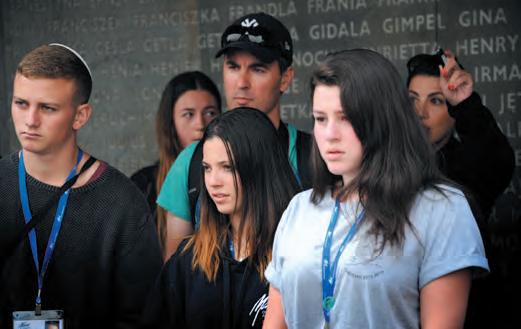
JHC Centre News 22
Fearless leadership is critical for a good society: reflections
Bill Appleby
Bill Appleby (centre) with Student MOTL participants at Belzec (photo courtesy Emmanuel Santos)
Some highlights of my March of the Living experience
Shira Rosenblum
At the Yom HaShoah ceremony at AuschwitzBirkenau, Rabbi Israel Lau’s speech to the March of the Living (MOTL) participants earlier this year was the one that resonated with me the most. He reminded us that we, the teenagers, are the last generation with the privilege of marching alongside Holocaust survivors, and that it is our duty to know them, to love them and to cherish them, because soon there will be no more survivors to tell us their tales of horror, pain and survival. Participating in the MOTL has given me the unforgettable opportunity to be where millions of my people were murdered, and I am proud to be a torchbearer for the next generation.
We walked the three kilometres between Auschwitz and Birkenau with thousands of Jews who march now for life and for memory – a path to the Birkenau death camp where hundreds of thousands of people, and more, were murdered. When we reached Birkenau, one of the boys in our group began to cry, so a number of us held onto him and, all supporting each other, we walked down the train tracks of Birkenau and completed our march.
Our second march, in Israel on Yom Ha’atzmaut to the Kotel, was such a contrast, as it was a celebration. No matter where you looked, you were surrounded by Jewish people from all over the world. As we marched, we sang, all singing the same songs with the same words. We marched to the Kotel as a nation, and I was filled with pride to be able to take part in such an incredible event.
I was also filled with pride at the ceremony that followed our walk through Majdanek, the concentration camp on the outskirts of Lublin. We stood by a pit where 18,400 had been murdered on one day in 1943, and as one of the girls rose to sing Shema Israel my friend leaned over to me and said, ‘Can you believe that we are sitting in a death camp listening to a Jewish girl singing a Hebrew song?’
We went to Majdanek with Celia, a survivor of Majdanek, Auschwitz and Birkenau. It was her first visit back to Poland since she was twelve years old, seventy years ago, and I was privileged to hold her hand as we walked. Celia wept as she told us stories that will stay with us forever. However, even though her family was murdered in that camp and she saw the worst of humanity, there was pride that she had survived, and she left the camp with a sense of closure.
One of the most powerful moments of the trip for me was at the Belzec death camp. The camp, where over 500,000 Jews were murdered, had been dismantled by the Nazis in 1943, and today there is a memorial in its place. There we had a moving and emotional ceremony where people shared poems, stories, songs and testimonies and lit candles before moving into the ‘echo room’ – a completely dark room made of concrete where footsteps, voices and even one’s breath echoes. We all sang
Acheinu, Hatikvah and Ani Ma’amin as a group, our voices echoing in the darkness. It was beautiful and I feel blessed to have had that experience.
It is difficult to describe MOTL adequately. I can say that it was special, sad, magical, confronting, scary, and an amazing opportunity, but these words do not do it justice. Ultimately, for me MOTL was about Jewish unity and continuity, friendship and strength. And despite the intensity of the program, it was not just about darkness and death, but about life and light as well.
I would like to end with a poem I wrote during our visit to Belzec:
As we drove, we saw the black rocks rising up from between the beauty of the green fields of the countryside.
As we walked, the walls reached higher and higher and higher until we were nothingness.
As we stood, the words of our fellows engulfed us into their stories, drawing us into pain and tears.
As we climbed, the stone walls pushed out as if the lonely souls behind them were calling ‘Remember us, never forget.’
As we descended, the world flew as wind and sun whipped our skin, biting our noses.
As we sat, darkness and song surrounded us each note another tear on the stone cold floor.
As we sang, I held my leader, mentor and teacher as anger, sadness and pride held us in the room of reflections and echoes.
As we cried, we remembered and we knew we could never forget, we would remember forever.
Shira Rosenblum, a Year 11 student at Leibler-Yavneh College, Melbourne, participated in the March of the Living Student Program in April 2014.
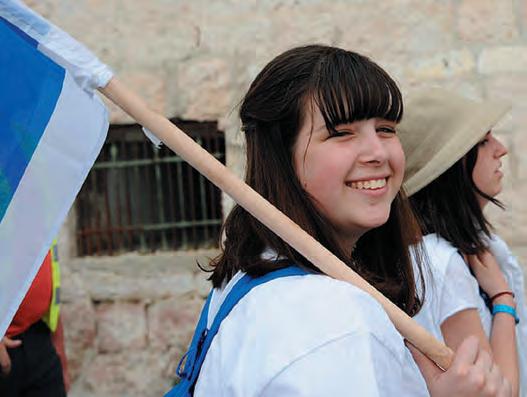
23 JHC Centre News
Shira Rosenblum in Jerusalem at the march from Saffra Square to the Kotel on Yom HaAtzmaut (photo courtesy Shira Rosenblum)
JHC Social Club
Barbara Sacks
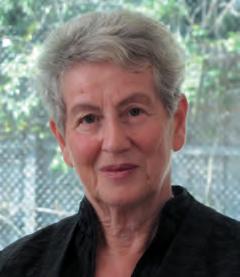
Ahighlight for many Holocaust survivors, volunteers and guides, and their friends, is the monthly meeting of the Jewish Holocaust Centre (JHC) Social Club. We aim to invite informative and entertaining speakers who cover a wide range of subjects, and our meetings never fail to generate lively and stimulating discussions.
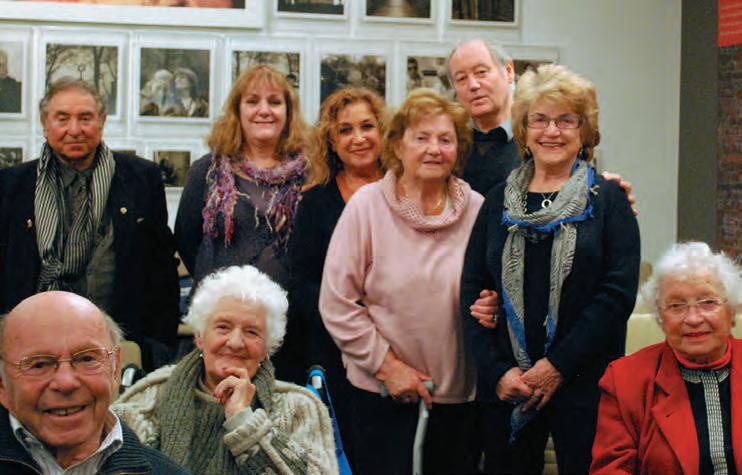
Our first guest speaker for the year was the inspiring Nina Bassatt AM. A child survivor of the Holocaust who has worked for many years in her private legal practice, Nina is currently the president of the Jewish Community Council of Victoria, and has been involved in several other communal organisations, both locally and internationally. She spoke to us about ‘Jewish communities, local, national and international’.
Media legend Phillip Brady, who has been entertaining audiences in Melbourne and beyond for many years, spoke about ’55 years in television and radio’. Mr Brady, who has hosted several television shows and worked with many leading television and radio personalities, reflected on his fascinating journey in the world of media.
Dean Levitan, Campaign Director of Jewish Aid, spoke about ‘Advocacy in the Jewish community’.
Dean is currently undertaking tertiary studies, but is passionate about social justice and the work of Jewish Aid and its current communitybased programs, which focus on refugee support, indigenous partnerships and international engagement.

Jenny Better, School Education Coordinator at the Jewish Museum of Australia is the creator of a groundbreaking education program titled ‘The Jewish Context of the Life and Words of Jesus’. This program has positioned the museum as a significant educational resource for
teaching about Jesus and his Jewish world, and Jenny gave a fascinating lecture on ‘Jewish Jesus at the Jewish Museum of Australia – Why?’
Ophthalmic surgeon Dr Mark Cherny spoke about ‘Different visions of the world’. Dr Cherny, whose interests include philosophy, religion, history, photography, cosmology, music and comedy, has been involved in a number of Jewish organisations and stimulated discussion with his views on the challenges and solutions he sees both in his professional work and in the Jewish community.
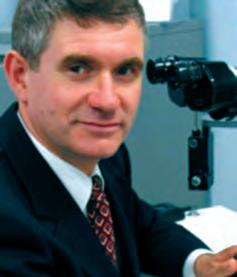
Michael Cohen, the JHC Community Relations Coordinator, spoke about ‘Stories from my visits to Jewish communities in South-East Asia and the Far East’. Michael, who in the 1980s served as Executive Director of the Asia-Pacific Jewish Association, entertained us with some interesting, amusing and unusual stories.
All are welcome to join us for bagels and coffee, and for stimulating and lively discussion. The club meets monthly on Thursday mornings at the Jewish Holocaust Centre.
For further information about the JHC Social Club, please contact Barbara Sacks on 0404 224 498.
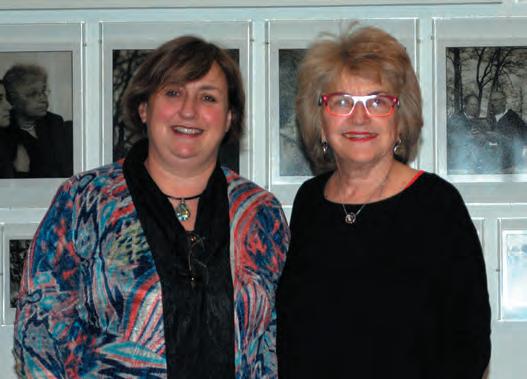
JHC Centre News 24
Dr Mark Cherny
Dean Levitan
(l-r) Jenny Better and Barbara Sacks
Nina Bassat AM
Michael Cohen (back right) with members of the JHC Social Club
Friends of the Jewish Holocaust Centre Goldie Birch
The Friends of the Jewish Holocaust Centre (JHC) played an important role in ensuring the success of the Centre’s 30 th anniversary gala dinner held in May. Our members invited their friends to make up tables, the Friends Committee assisted with decorating tables and welcoming guests on the night and, at the conclusion of the official proceedings, we collected pledge forms for the appeal. We are delighted that the evening was so successful, both socially and financially.
In June, Friends presented a special film screening of Grace of Monaco at the Classic Cinemas, with the funds raised going to the Jewish Holocaust Centre.
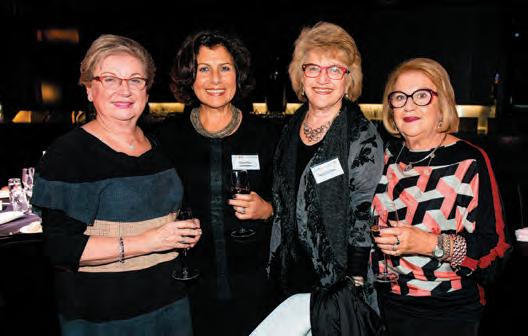
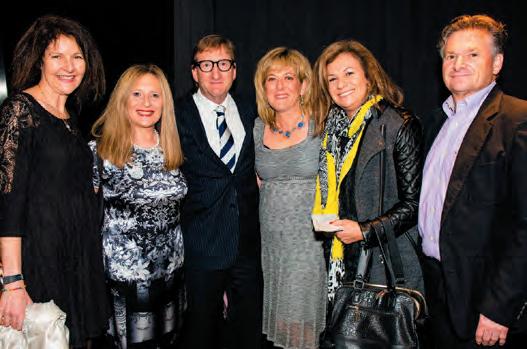
On behalf of the Friends of the JHC, I would like to wish everyone a very happy and healthy New Year and well over the Fast.
Become
The Friends of the Jewish Holocaust Centre plays an important role in providing financial support to the Centre through membership subscriptions, raffle book sales, sales of the Entertainment Book and social fundraising functions.
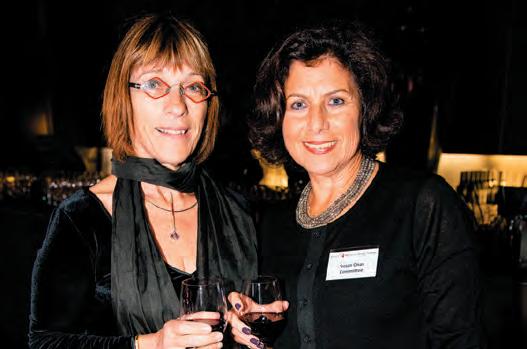
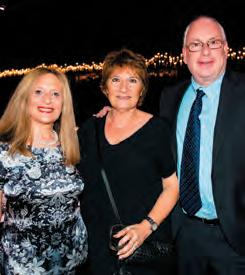

To become a Friend of the Jewish Holocaust Centre, simply download
and complete the form from www.jhc.org.au/friends-of-the-jhc.html
For further information please contact Goldie Birch on (03) 9528 1985 or email goldiegb@bigpond.net.au.
JHC Centre News 25
FRIENDS
(l-r) Mandy Slade, Goldie Birch, Alan Wein, Caroline Wein, Susie Rosenthal and Barry Zayon
a Friend of the Jewish Holocaust Centre. Support the activities of the Centre.
(l-r) Swieta Fleiszig, Susan Onas, Barbara Sacks and Marilyn Fayman
(l-r) Sara Smulevich and Sabbie Berger
l-r) Goldie Birch, Helen Mahemoff and Irving Birch
(l-r) Elly Brooks and Susan Onas


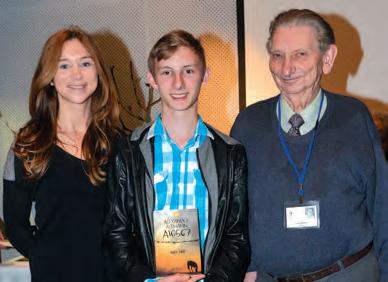
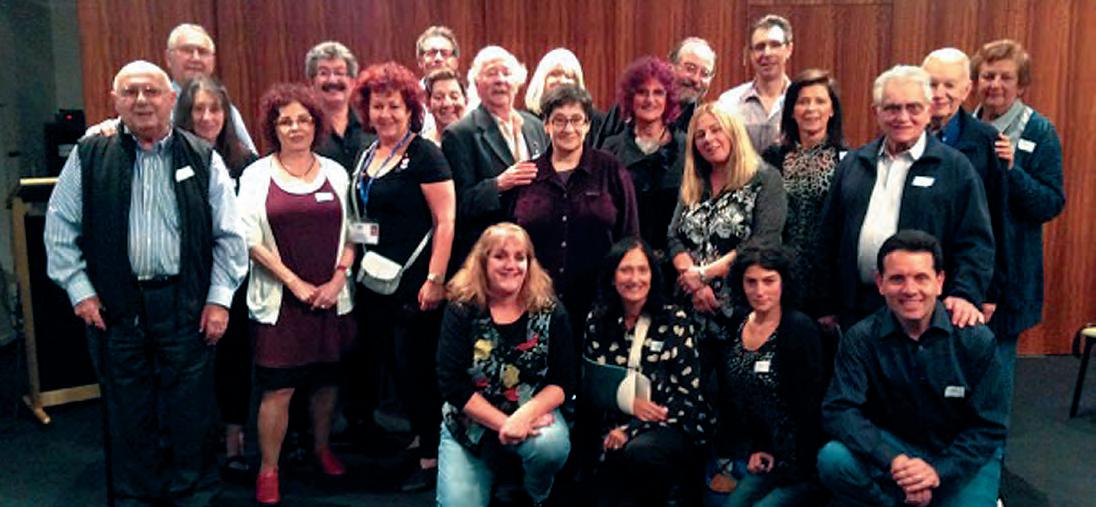
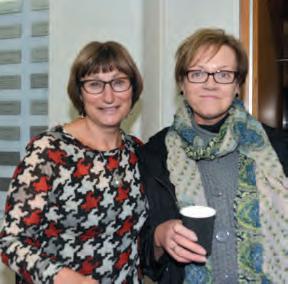
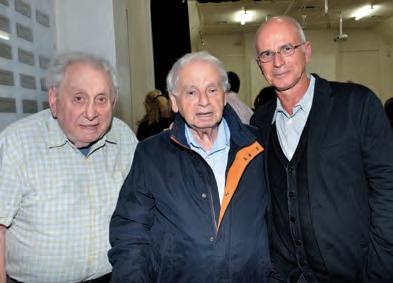 (l-r) Suzy Zail, Connor Lenti and Fred Steiner
(l-r) Suzy Zail, Connor Lenti and Fred Steiner
SEEN AROUND THE CENTRE 26 JHC Centre News
(l-r) Edna Lipson, Warren Fineberg, Nicole Gandel, Jonathan Zimmet, Madeline Edwards and Dr Dvir Abramovich
(l-r) Henri Korn and Avi Paluch
Adult March of the Living 2004 Ten-Year Reunion
(l-r) Gita Ginger and Mary Stawski
(l-r) Frank Dobia, Yossel and Johnny Baker
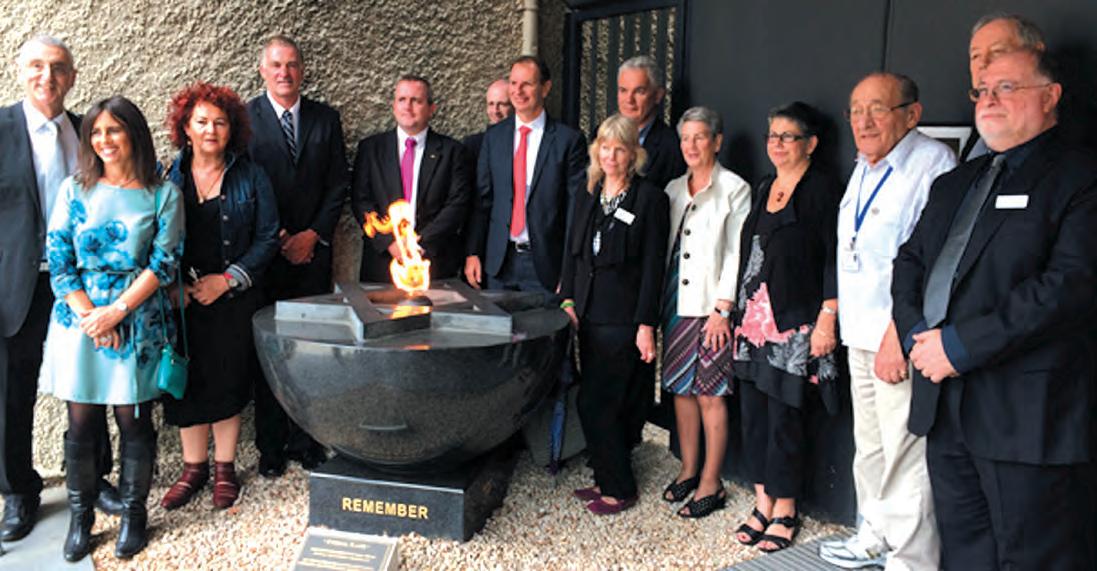



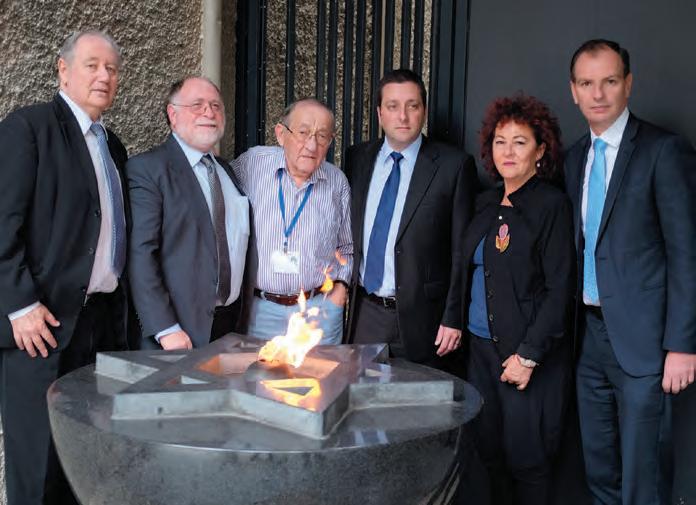

JHC Centre News 27
Victoria State and Local Government politicians with representatives of the Jewish Community Council of Victoria and the Jewish Holocaust Centre
(l-r) Michael Cohen, Warren Fineberg, Moshe Fiszman, the Hon Matthew Guy MLC, Pauline Rockman OAM and the Hon David Southwick MP
(l-r) Adam Thalhammer and Adam Brown
(l-r) Michael Cohen, Warren Fineberg and His Excellency Paul Madden, British High Commissioner
(l-r) Julia Reichstein, Shirley Randles and Lisa Phillips
Susie Ehrmann and Prof Andrew Markus
Not willing just to stand by
Jayne Josem
Icame across an incredible letter in the Jewish Holocaust Centre’s collection recently. I was taken aback both by its content and by the fact that it related to another series of items in our collection, a connection that had not yet been established.
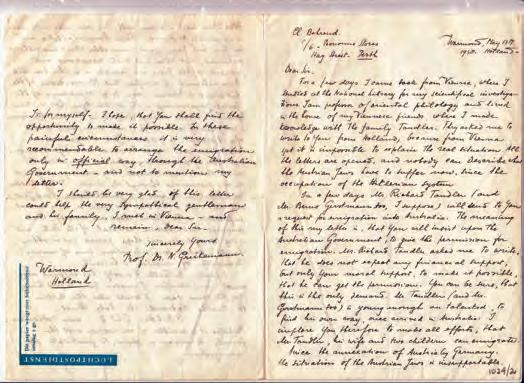
The sender, Professor Dr N Greitemann from Warmond, Holland, refers in the letter to the Tandlers, a Jewish family he met while visiting Vienna. This caught my attention as we have a whole set of items in the collection related to this family who migrated to Australia in 1939, fleeing Vienna just after Kristallnacht in November 1938. Their suitcase and other memorabilia are proudly displayed in our museum, representing the ‘lucky ones’ who escaped Hitler’s clutches. They had organised their permits through relatives in Australia.
Most of the letters in our collection are in Polish, German or Yiddish, as well as a range of other languages, but Prof Greitemann’s is unusual as it is written in English. It was refreshing for me to be able to pick up a letter from the collection and simply read it myself since I do not read Polish, German or Yiddish. And as I read, my jaw began to drop!
Prof Greitemann, who was not Jewish, had come to Vienna in April 1938 to study Oriental Philology at the National Library. During his visit he met the Tandlers at a mutual friend’s house. The Tandlers asked him to write to the Behrends, their relatives in Australia, when he returned to Holland, and when he returned in May 1938, he immediately did as he was asked. In his letter to the Behrends he wrote:
[The Tandlers] asked me to write to you from Holland, because from Vienna yet it is impossible to explain the real situation. All the letters are opened and nobody can describe what the Austrian Jews have to suffer now, since the occupation of the Hitlerian system.

Prof Greitemann’s letter continues:
The meaning of this my letter is, that you will insist upon the Australian Government, to give the permission for emigration. Mr Richard Tandler asked me to write, that he does not expect any financial support, but only your moral support, to make it possible, that he could get the permission. You can be sure, that this is the only demand. Mr Tandler is young enough and talented, to find his own way, once arrived in Australia. I implore you therefore to make all efforts, that Mr Tandler, his wife and two children can emigrate.
As a result of the professor’s letter, the Behrends did in
fact sponsor the Tandler family’s emigration and successfully rescued about twelve members of their extended family.
The first thing that impressed me when I read the letter was that the professor was a good man, and a man of his word because he actually chose to act. In doing so, he helped a family who was desperate, while others in similar situations simply turned a blind eye.
The second aspect of this letter that is quite astounding is the level of detail in the professor’s descriptions of the scenes he witnessed in Vienna. He wrote:
Since the annexation of Austria by Germany, the situation of the Austrian Jews is insupportable. What I have heard and seen with my own eyes in Vienna is impossible to describe. I am Roman Catholic and no Jew, but I am (and many other Christians with me) ashamed, that these and such vexations and torments of the Jews are possible in a Christian State. I am ashamed to confess that the vexations of the last times in Vienna seem to be repetitions of the Jewish persecutions in the Middle Ages. Their Christian friends in Austria cannot help them, because the terror is very strong and hard, and every word or act of a Christian to support a Jew is regarded as revolution and must be paid also by vexations and often by incarceration. Jews are compelled to scrub streets and barracks, they must go in a ridiculous procession through the streets. It is forbidden for a Christian to buy in a Jewish Trade; no Jew can visit a theatre, the opera or a musical performance. The Jewish shops are empty, their business under special control of the State, and a big lot of trades and shops passed yet in other hands - sealed for a ridiculous sum of money! The number of suicides is horrid.
These lines contain objective eyewitness testimony to the early days of the Nazi campaign of terror against its Jewish subjects. Prof Greitemann also articulates the difficulty for Christians in Austria in standing up for others. I was particularly touched by his expression of shame about the acts he witnessed and how, as a religious man, he felt it to be against the teachings of Christianity.
Professor Greitemann disappeared from view, having played his small but enormously significant part in the fate of the Tandler family. Richard Tandler, an immensely talented architect, silversmith and photographer, brought his skills and his family to Australia, his wife Bertha, their twin ten year-old daughters, Susanne and Lieselotte, and two of their grandparents as well.
28 JHC Centre News STORIES FROM THE COLLECTION
What makes the Holocaust different?
Paul Bartrop
Iteach courses on the Holocaust and genocide. Frequently, the question comes up: ‘Was the Holocaust unique?’ My answer is always the same. The Holocaust of the Jews was, quite clearly, a singular event – just as the Armenian Genocide was different from the genocide in Rwanda, the Cambodian Genocide was different from the genocide in Bosnia, and the genocide in East Timor was different from Darfur Genocide. Each has its individual characteristics, distinct from those of others. Despite this, the Holocaust was Different (with a capital D) – in scale, in breadth, and in its origins, though knowing that still leaves me suspicious of arguments asserting Holocaust uniqueness. The idea sets historians up for unnecessary confrontation, as all historical phenomena are of themselves unique in that they will never again occur in exactly the same way, or according to the time-and-place circumstances in which they happened. Every genocidal act of the past century, whether of the Hereros, Armenians, or Ukrainians, or whether taking place in East Timor, Cambodia, Bosnia, or Rwanda, has been characterised by specific developments that cannot be transferred from one setting to another. Possibly the best that objective historians can hope to identify in these events are the features that are common or different, and from this ascertain whether some sort of general pattern can be discerned.
What, then, should be the key question about the Holocaust? Perhaps what needs to be asked is not ‘Is the Holocaust unique?’ but, rather, turning the issue upside down, ‘What is unique about the Holocaust as a case of genocide?’ In other words, we should assume its uniqueness (as we should do with all others genocides as well), and then move straight away to identifying the feature or features that define its specific character.
The methods the Nazis employed to achieve their murderous aims could be found in the death camps, and it is these institutions, thoroughly unprecedented in purpose and design, that make up the starkest feature of the Holocaust. Nothing, either before or since, approximates
Phillip Maisel Testimonies Project
The Jewish Holocaust Centre has over 1,300 video testimonies, as well as over 200 audio testimonies in its collection. These provide eyewitness accounts of the horrors of the Holocaust, together with glimpses into the vibrancy of pre-war Jewish life in Europe. The collection is widely used by researchers and students of oral history, the Holocaust and a variety of other disciplines.
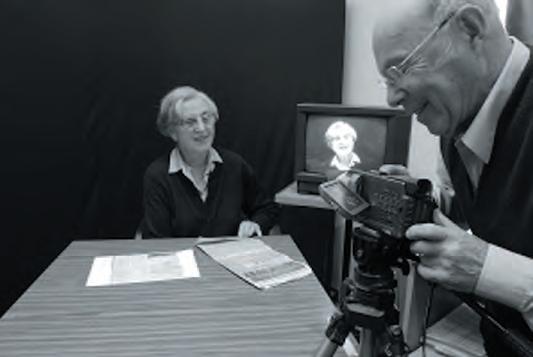
If you would like to give your testimony or know of someone who is interested in giving a testimony, please contact Phillip Maisel. Phone: (03) 9528 1985 or email: testimonies@jhc.org.au
the Nazi death camps in design, intention or operation. This is not to say, of course, that other totalitarian regimes have not also possessed places of relentless torture and murder. One has only to look at any example, from the Soviet or Chinese gulags, at Tuol Sleng prison in Pol Pot’s Cambodia, at Omarska and other concentration camps in Serb-dominated Bosnia, at the Drapchi prison in Tibet, or at the so-called ‘re-education’ camps of North Korea. But nowhere have any of the regimes that produced malevolent concentration camps or prisons introduced establishments like the Nazi death camps of Lublin-Majdanek, Treblinka, Bełzec, Sobibór, Chełmno, or Auschwitz-Birkenau. They were, and remain, thoroughly unmatched in human history. All Nazi concentration camps were places of unmitigated horror, where life was cheap and characterised by hard work, poor diet, over-crowded and unsanitary living conditions, and SS cruelty. Death by beating, bullets or other means lurked around every corner. Disease and starvation became constant companions; deprived of all rights, ordinary inmates were subjected to the caprice of Nazi guards and kapos. But it was the death camps, specifically, that characterised the Nazi state most clearly. A departure from anything previously visualised in both their design and character, they were institutions designed to murder, methodically and efficiently, millions of people. As such, they became the most lucid and unequivocal statement German National Socialism made about itself, demonstrating beyond doubt that it was an anti-human ideology in which respect for life counted for nothing. Put together, all these aspects of what the death camps represented added up to a new dimension of genocide. When I am asked about Holocaust uniqueness it is this singular feature that becomes ‘ground zero’ for all further examination – something on which we should all reflect when this question arises.
Dr Paul Bartrop has served as consultant historian at the Jewish Holocaust Centre. He is currently history professor and director of the Center for Judaic, Holocaust, and Genocide Studies at Florida Gulf Coast University, Fort Myers, Florida, USA.

JHC Centre News 29
Dr Paul Bartrop
William Cooper remembered through the Jewish Holocaust Centre, Wilson Family Scholarship
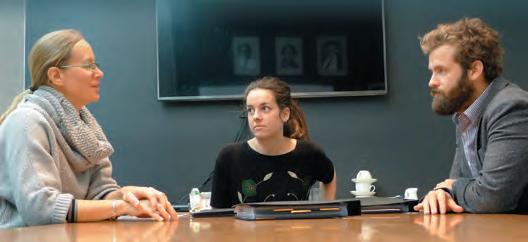
In late 2013 the Jewish Holocaust Centre (JHC) was approached by Tauba and Dennis Wilson and their daughter and son-in-law, Nina and Nick Yates, to establish a scholarship offering financial assistance to indigenous university students.
Nick has spent many years working in indigenous education. Following a visit to the JHC museum in 2013, he discovered the story of William Cooper, the aboriginal human rights activist who in November 1938 marched from his home in Footscray to the German Embassy in Collins Street to deliver a letter to the German Government protesting against the treatment of Jews during Kristallnacht
This story of one man’s protest against a powerful totalitarian government did not receive much publicity at the time, but is now well documented, raising the awareness of Cooper’s actions. William Cooper’s memory has recently
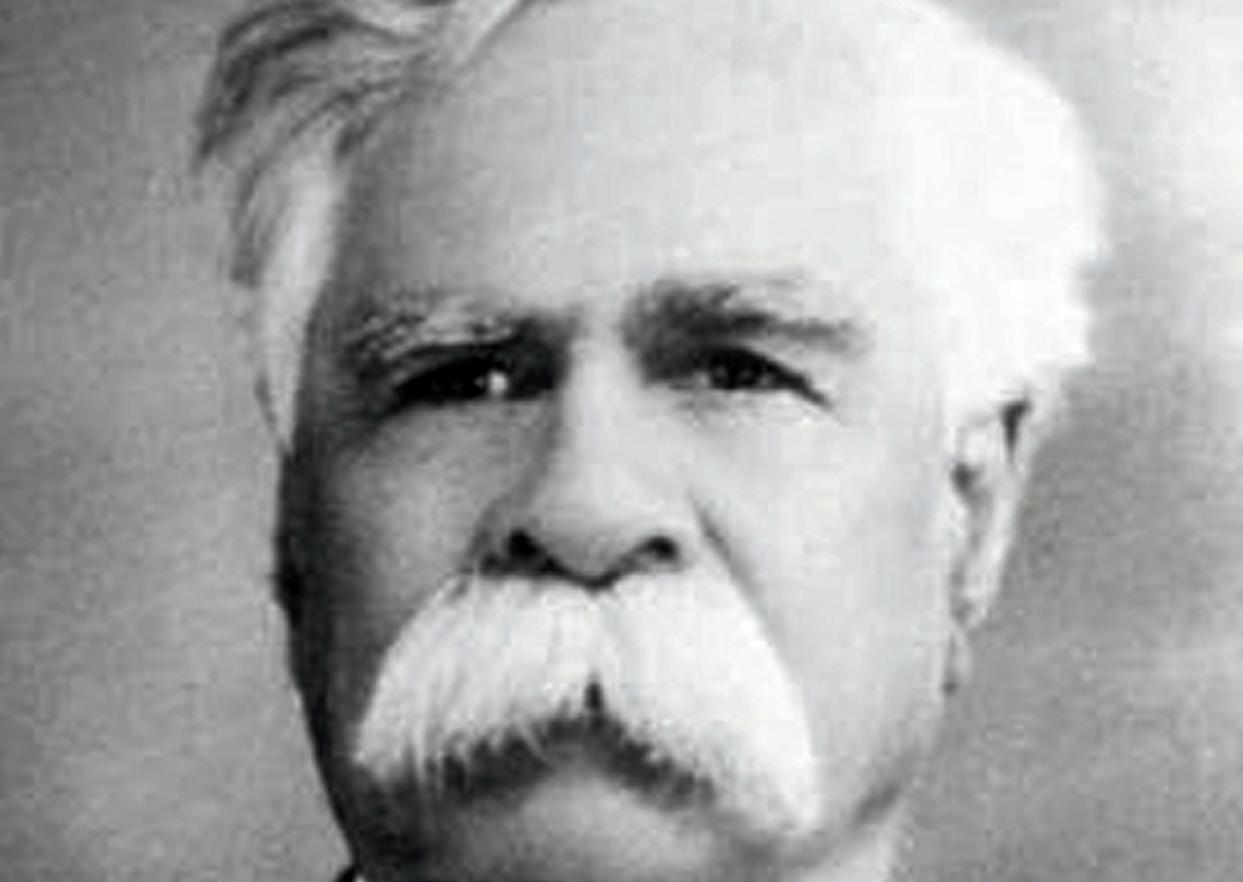
been honoured in the naming of a law court in Melbourne and a pedestrian bridge in Footscray. His protest is an example of the impact one person can have, even if that impact is felt decades later.
And so to Nick Yates in 2013… Wanting to combine their support of the Jewish Holocaust Centre with Nick’s experience in indigenous education, the Wilson family established the ‘Jewish Holocaust Centre, Wilson Family Scholarship in Memory of William Cooper’. For the next three years, scholarships will be awarded annually to two students, one from Monash University and one from Deakin University.
The inaugural scholarship recipients are Jessica Rodaughan from Monash University and Christian Woodward from Deakin University. Jessica is in her final year of a Bachelor of Arts Global degree and Christian is enrolled in a Bachelor of Social Work degree. Over the next few months Jessica and Christian will be working at the JHC on projects relating to their university studies.
We would like to thank the Dennis and Tauba Wilson and Nina and Nick Yates for their ongoing support of the Centre and its mission.

JHC Centre News 30
(l-r) Jayne Josem, Jessica Rodaughan and Nick Yates
Simon Michalowicz (z”l) – our Buchenwald Boy
Michael Cohen
In May this year Simon (Shimon) Michalowicz, a muchloved and respected survivor guide at the Jewish Holocaust Centre (JHC), a cherished friend and a kind, gentle man, passed away.
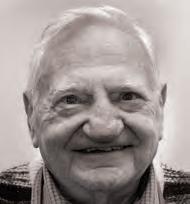
Simon was born in 1929 in Wielun, Poland. When Wielun was bombed on 1 September 1939, at the outbreak of the Second World War, he was nine years old. On that day, his life – like that of countless others – changed forever. Simon lost his childhood, and spent the following five years in several Nazi concentration camps – from the Zwerzenice work camp in 1940 to Auschwitz in 1942. At Auschwitz he was processed, deemed fit to work, given the number that remained tattooed on his arm – 124767 – and allowed to live. His ten-year-old brother, Zeesl, who was with him at the time, was murdered.
Simon spent two years working as a slave labourer in Blechammer, one of the satellite camps of Auschwitz. In 1944, he was forced onto a Death March, which he barely
survived, from Gross Rosen to Buchenwald where he was liberated by the American Army on 11 April 1945. He was one of approximately 1,000 boys to survive Buchenwald. In Melbourne, and wherever they eventually resettled, these boys became known as the ‘Buchenwald Boys’.
Simon was a Buchenwald Boy.
Simon miraculously survived the war, but was left an orphan. Two of his sisters also survived, but most of his family were murdered in the Holocaust. He lost his mother, Cela; his sisters, Hinda, Faiga and Chana; and his brothers, Avram Wolf, Yaakov Yosef and Zeesl.
Simon is survived by his wife, Esther, his daughters Susan and Annette, together with his sons-in-law, grandchildren and great-grandchildren.
Yehi Zichro Baruch. May his memory be a blessing for us all. Michael Cohen is Community Relations Coordinator at the Jewish Holocaust Centre.
Ruth Crane: making the world a better place
Bernard Korbman
Ruth Crane

Ruth Crane was a softly spoken woman of great warmth and charm. She was unassuming, with no sense of selfaggrandizement. Yet when Ruth spoke to young students at the Jewish Holocaust Centre there was a certain glow about her, and the students responded with respect, gratitude and affection towards her for sharing her harrowing experiences. In an interview Ruth stated, ‘When we speak we must connect. Talk is not enough, to convey is not enough; we must connect.’ And connect she did. Ruth felt a strong duty of care towards the students who came to the Centre. Understanding the horrific nature of the subject matter and the difficulty that some young people might have in coping with both the barbarous experiences that the survivors went through and some of the graphic photos in the museum, Ruth always made sure that young people left the Centre with hope in their hearts and, hopefully, with a commitment to actively help anyone who suffered persecution.
Of all the survivors, Ruth was the only one who spoke to me about camp life from what Holocaust scholars call a ‘feminist perspective’. She spoke about women maintaining their identity and strength through the exchange of recipes, and how they would plan their meals for Shabbat or the festivals as they occurred. Ruth recounted the strength of song, sung in whispers between friends, as a way of maintaining hope
and reminding themselves that they were human. And, it was Ruth who first alerted me to the significant differences in camp drawings between those drawn by men and those drawn by women. While men and women shared the same fate and their daily existence was more or less similar, differences between their experiences of camp life did exist. Women were constantly trying to recreate the world of normality, and they produced drawings depicting washing, cooking, cleaning and friendships. Men mostly drew the harsh reality of camp life, the beatings, the humiliation and death.
Ruth’s resilience throughout her life was connected to her religious faith. It was not a passive faith, giving in to the notion of ‘what will be will be’. Rather, it was a belief that God would support and enhance her ability to take responsibility for her own emotions and actions, no matter what the circumstances. Ruth’s pride in being Jewish and her faith and determination in accepting responsibility for her life choices made this diminutive woman a gentle tower of strength.
With Ruth’s passing, another light has dimmed at the Jewish Holocaust Centre, but through her legacy, the sun shines brighter and the world is a better place.
Bernard Korbman is the former Executive Director of the Jewish Holocaust Centre.
JHC Centre News 31 OBITUARY
Simon Michalowicz
Engagement
To Leonie Nossbaum on the engagement of her daughter Carly Szafran to Eyal Genende
Marriage
To Joy and Nathan Bloumis on the marriage of their granddaughter Katie Vinson-Bromberger to Jacob Rotstein
Births
To Bill and Esther Anderson on the birth of their granddaughter Lily Glastonbury
To Tosca Birnbaum on the birth of her grandson Zimaa Birnbaum
To Ursula Flicker OAM on the birth of her great grandson Felix Forgasz-Kertesz
To Marika and Allen Brostek on the birth of their grandson Felix Forgasz-Kertesz
To Helen and James Hendy on the birth of their son Arthur Hendy
Births (cont)
To Tuvia Lipson on the birth of his great granddaughter Olivia Lipson
To Susan and John Onas on the birth of their grandson Asher Onas
To Tamara Schneier on the birth of her granddaughter Basha Rivka Schneier
Birthdays
To Saba Feniger on her 90th birthday
To Maria Lewitt OAM on her 90th birthday
To Freda Schweitzer on her 90th birthday
Bar Mitzvahs
To Rachel Cymbalist and her family on her bat mitzvah
To Adele Pakula on the bar mitzvah of her grandson Vincent Page
Condolences
To Helen Leperere on the death of her son-in-law Peter Horak
To Esther Michalowicz on the death of her husband Simon Michalowicz
To Frankie and Stephen Pinch on the death of their father and father-in-law Mark Zandle
To the family of Rochel Sztajer on her death
To Bronia and John Witorz on the death of their mother and mother-in-law Fela Goldman
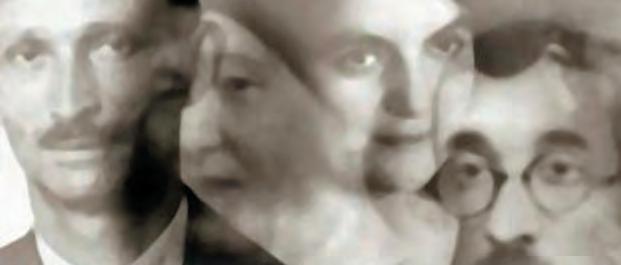
To the family of Max Zilberman on his death
Members of the Board, Staff and Volunteers of the Jewish Holocaust Centre extend their deepest sympathy to JHC President Pauline Rockman OAM, Jordy, Diego, Tahli, Michael, Julian, Lucia and Salvadore on the sad loss of Sean Rockman husband, father, father-in-law, and grandfather. Our thoughts are with Pauline, her children and grandchildren.
Become a Partner in Remembrance
The Jewish Holocaust Centre Foundation ensures the continued existence of the Centre and supports its important work. Funds raised through the Foundation are invested, with the earnings providing an ongoing source of income for the Centre to support its operations and programs into the future. For more information on how you can help support the Foundation and how your support will be recognised, please contact Helen Mahemoff, Chair of the Foundation on 0417 323 595 or Email: jhcfoundation@bigpond.com.
JHC Centre News 32 Mazal Tov
Friends of the Jewish Holocaust Centre is pleased to be selling the Entertainment Books again this year to raise funds for our Centre. You can now choose between the traditional Entertainment Book or you can purchase the brand new Digital Membership which puts the value of the Entertainment Book into your iPhone or Android smartphone, all for just $65! Please show your support by visiting the link below and purchasing your membership today:
https://www.entertainmentbook.com.au/orderbooks/188738b

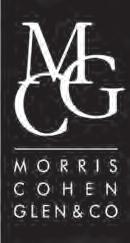
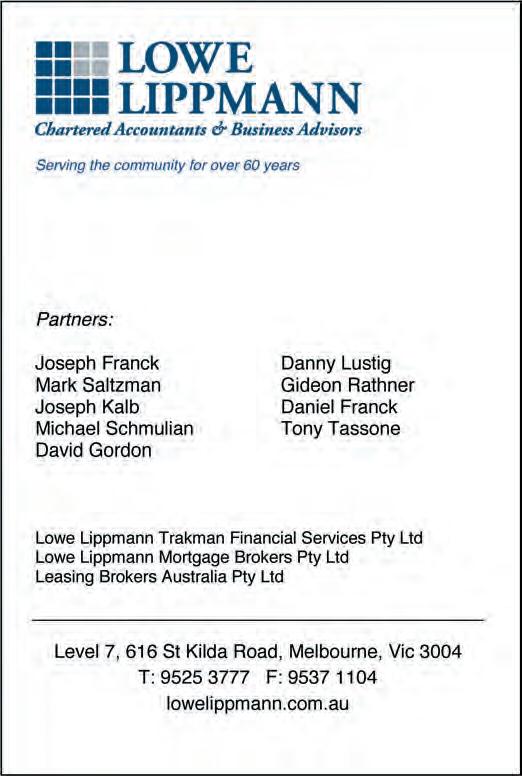
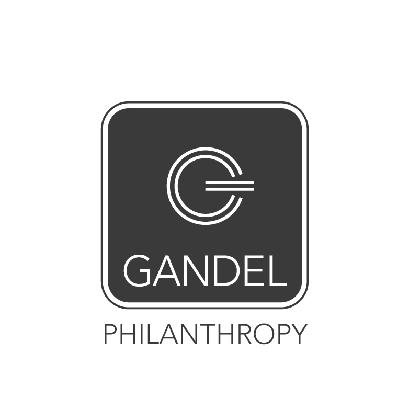
JHC Centre News 33 The Gandel Family and Gandel Philanthropy congratulate the JHC on its achievements and contribution to Holocaust education over the past 30 years. 1198 Toorak Rd Camberwell Vic 3124 Telephone: (03) 9804 0888 Facsimile: (03) 9804 0322 Website: www.morco.com.au CHARTERED ACCOUNTANTS Contact – Martin Artenstein ADVERTISING If you would like to advertise in this section please contact Reuben Zylberszpic Email: ReubenZ@jhc.org.au Phone: (03) 9528 1985
Order your 2014 2015 Entertainment Membership™

JHC Centre News 34

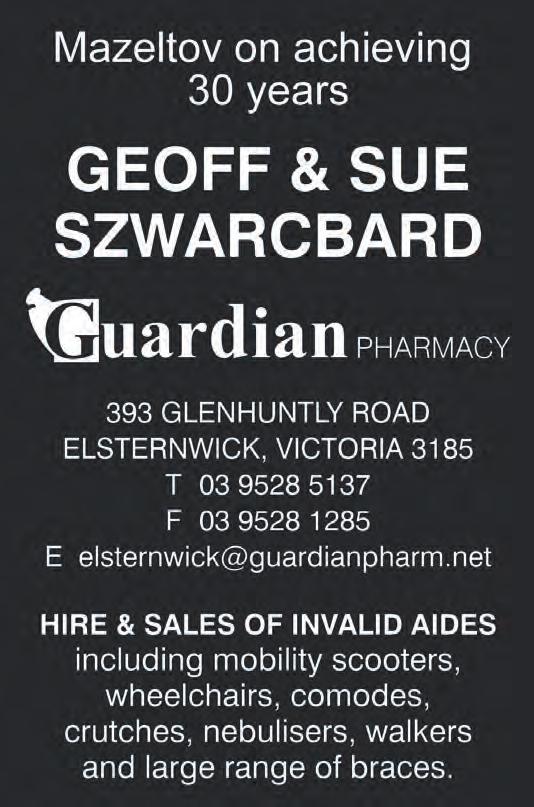


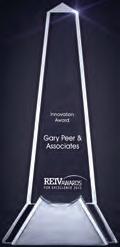
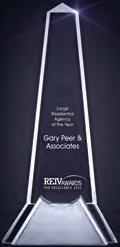
JHC Centre News 35





JHC Centre News 36 The Flamm family congratulates the Jewish Holocaust Centre on its 30th anniversary Congratulations on your 30th anniversary KATZ SILVER LAWYERS Suite 1, 71 Kooyong Road, Caulfield North 3161 Ph: 8508 8300 Fax: 8508 8399 Conveyancing, Wills & Estate Leases, Litigation and Business Law

JHC Centre News 37

JHC Centre News 38

JHC Centre News 39
September 2014 Jewish Holocaust Centre


Thank you to all who attended the gala dinner in celebration of the Jewish Holocaust Centre’s 30th anniversary
30th Anniversary Supporters
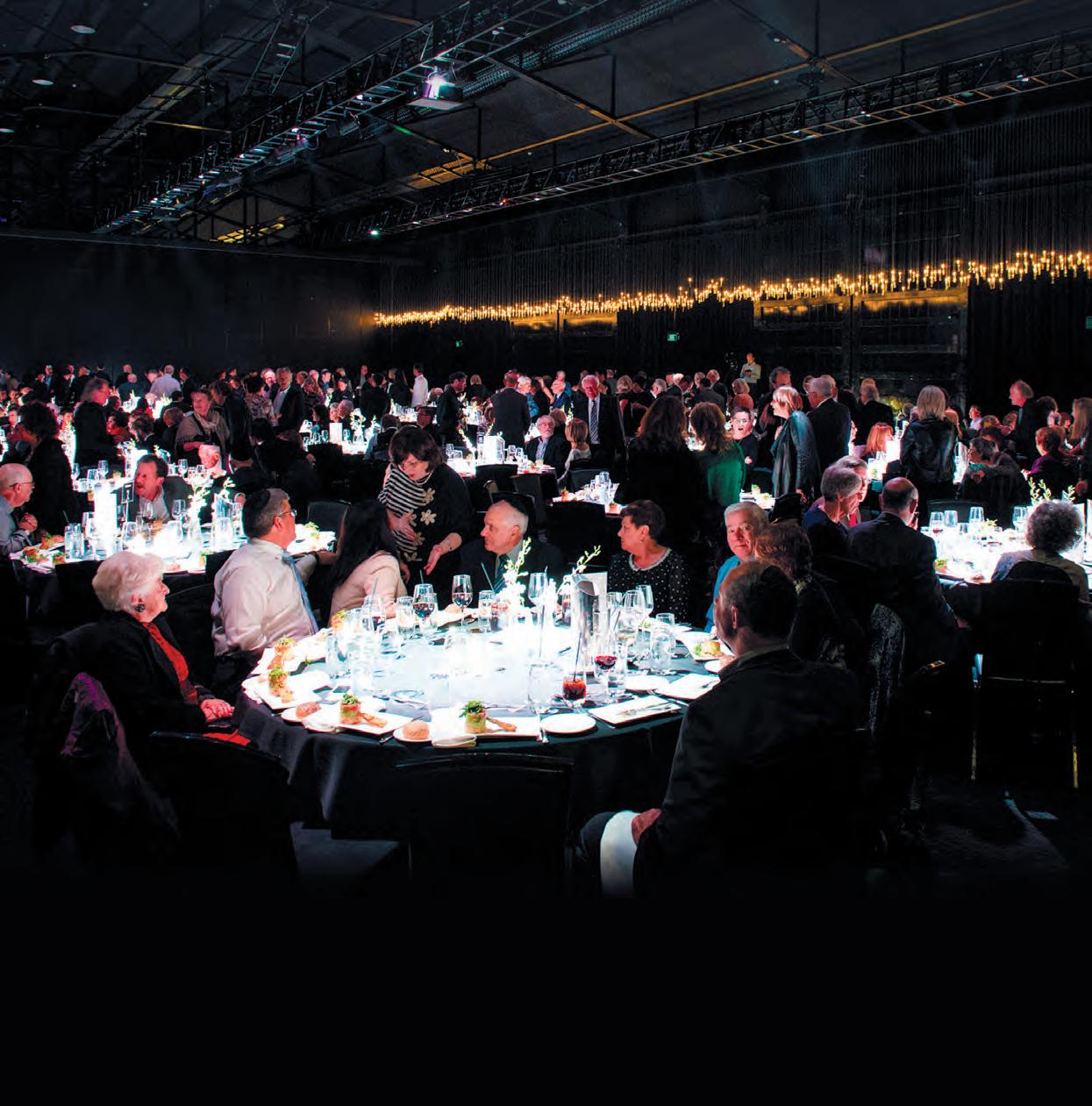
Registered by Australia Post. Publication No. VBH 7236
Les & Kathy Janovic (in memory of Dezso and Medi Janovic)
The Gandel Family and Gandel Philanthropy
Photography: Simon Shiff






























 (l-r) Robert Hanner, Irma Hanner and Mary Mass Hanner
(l-r) Saba Feniger, Goldie Birch, Rosa Freilich, Phillip Maisel OAM and Elly Brooks
(l-r) Tammy Reznik and Robbie Simons
Halina Zylberman
(l-r) Ronit Hoppe, Pola Hoppe and Josh Hoppe
Lior
(l-r) Helen Mahemoff, David (Doov) Cohen, Pauline Rockman OAM
(l-r) Karen Goldman, Michelle Rothman, Leon Rothman, Niki Saltzman, Mark Saltzman and Goldie Birch
(l-r) Judy Seigel, Max Stern and Magda Levy
Major-General Ido Nechushtan (Ret)
(l-r) Robert Hanner, Irma Hanner and Mary Mass Hanner
(l-r) Saba Feniger, Goldie Birch, Rosa Freilich, Phillip Maisel OAM and Elly Brooks
(l-r) Tammy Reznik and Robbie Simons
Halina Zylberman
(l-r) Ronit Hoppe, Pola Hoppe and Josh Hoppe
Lior
(l-r) Helen Mahemoff, David (Doov) Cohen, Pauline Rockman OAM
(l-r) Karen Goldman, Michelle Rothman, Leon Rothman, Niki Saltzman, Mark Saltzman and Goldie Birch
(l-r) Judy Seigel, Max Stern and Magda Levy
Major-General Ido Nechushtan (Ret)

























 Edited by Donna-Lee Frieze
Edited by Donna-Lee Frieze



















 (l-r) Suzy Zail, Connor Lenti and Fred Steiner
(l-r) Suzy Zail, Connor Lenti and Fred Steiner













































